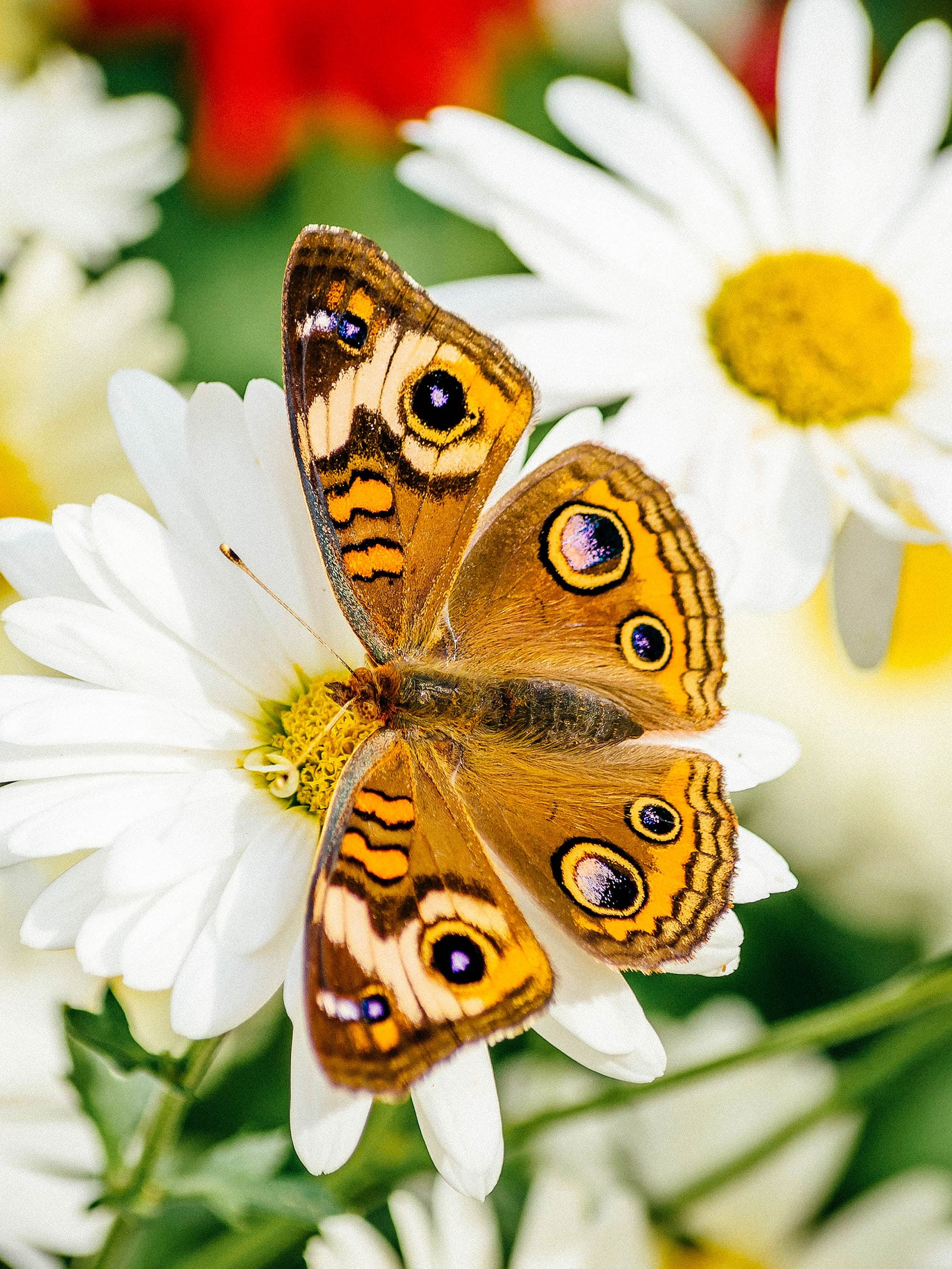Butterflies make frequent appearances in our gardens but sometimes it can be tricky to tell what they are. Certain butterflies are instantly recognizable (like monarchs) while others are so similar-looking (hello, swallowtail genus) that it’s hard to pinpoint the exact species. And while you might think you’ve just spotted a monarch with its striking coloration, it actually has a few copycats that can throw you off!
There are also beautiful garden moths that look like butterflies, and common butterflies that are so nondescript, people sometimes mistake them for moths.
So, the first thing you should know when trying to identify the flutterby you see in your yard (as my family affectionately refers to these winged beauties) is…
Butterfly or moth?
Can you tell the difference? Butterflies and moths belong to the family Lepidoptera and have delicate, patterned, and often colorful wings. The adults are often seen feeding on the nectar from your flowers, and both groups are important pollinators.
When butterflies and moths begin their lives as caterpillars, it’s hard to discern one from the other. But once they metamorphose into flying insects, their physical differences become more apparent. You can often tell butterflies and moths apart by checking a few key characteristics:
| Butterfly | Moth | |
| Antennae | Long with a club-shaped end | Short and feathery |
| Colors | Often very bright | Often more camouflaged |
| Wing position | Closed and pointing up in resting position | Open and parallel to the body in resting position |
| Pupal stage | Caterpillar makes a hard shell (chrysalis) | Caterpillar makes a soft cocoon |
| Body | Usually thin | Usually thick, sometimes fuzzy |
| Activity | Usually during the day (diurnal) | Usually at night (nocturnal) |
Did you know?
Moth species outnumber butterfly species almost tenfold (around 160.000 vs. around 18.000). Because moths are usually duller in color, smaller, and less conspicuous, though, the butterflies tend to get all the credit.
Once you’ve determined that the winged creature in your garden is, indeed, a butterfly, see if it matches up with any of these common species.
Genus Papilio: the swallowtails
Eastern tiger swallowtail (Papilio glaucus)
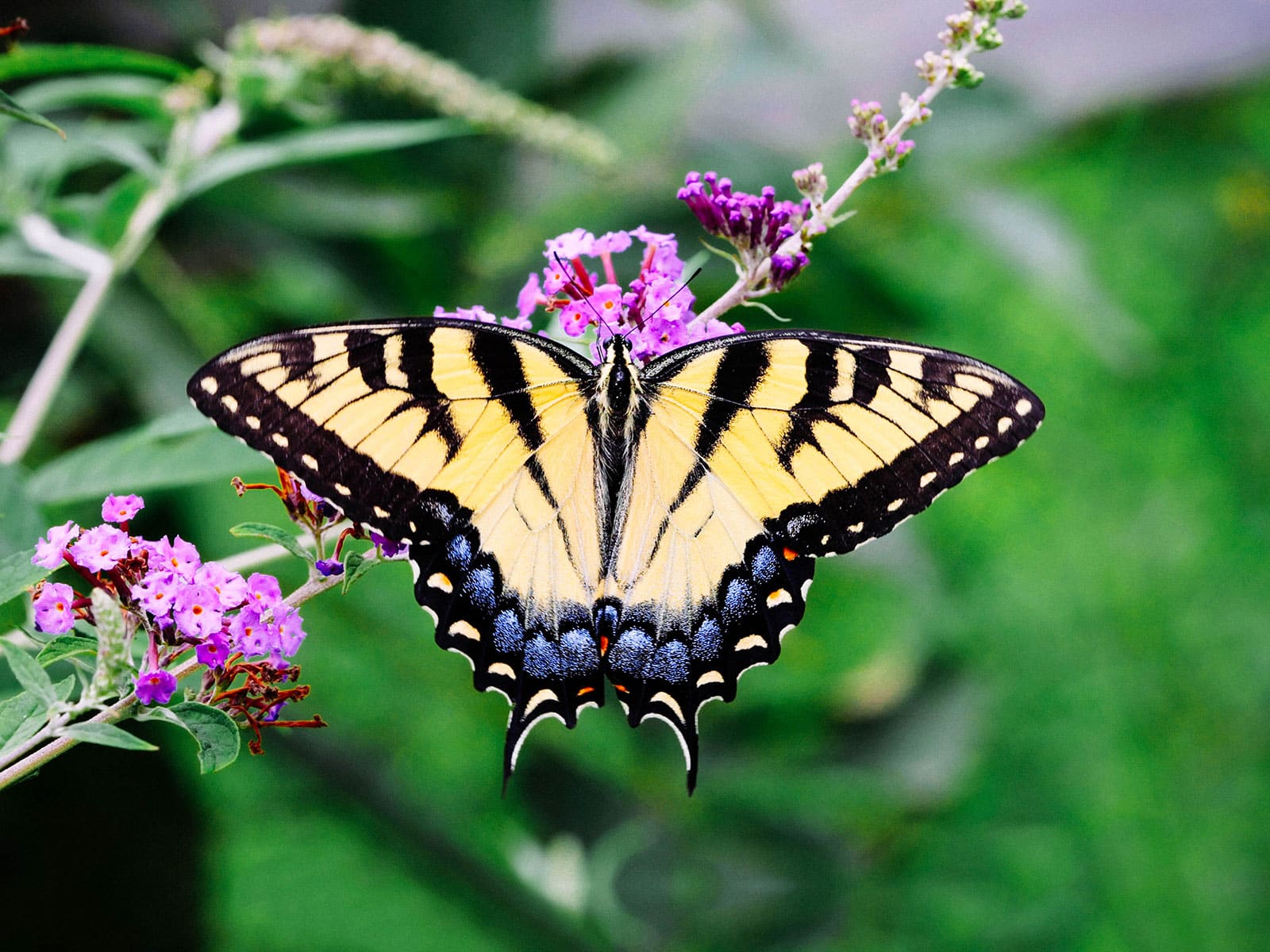
If you live in the eastern United States or southeastern Canada, one of the most striking butterfly species you can come across in your garden is the eastern tiger swallowtail.
With a wingspan of up to 5 1/2 inches and black-rimmed, bright yellow wings covered in a tiger-stripe pattern, this is one of the easier butterflies to identify. It’s active from spring to fall and mainly likes woodlands. This being said, it’s not very fussy about which flowers it feeds on, so it can also be found in parks and backyards.
Caterpillar: Found on a variety of plants, including those in the magnolia and rose family. It’s big and green to brown, with prominent eye spots on the side of the head.
Did you know?
A dark brown color morph exists in female eastern swallowtails. If you see a brown one, it’s always a girl! In yellow specimens, you can tell the difference between males and females by the blue hue the latter has on her “tail.”
Western tiger swallowtail (Papilio rutulus)
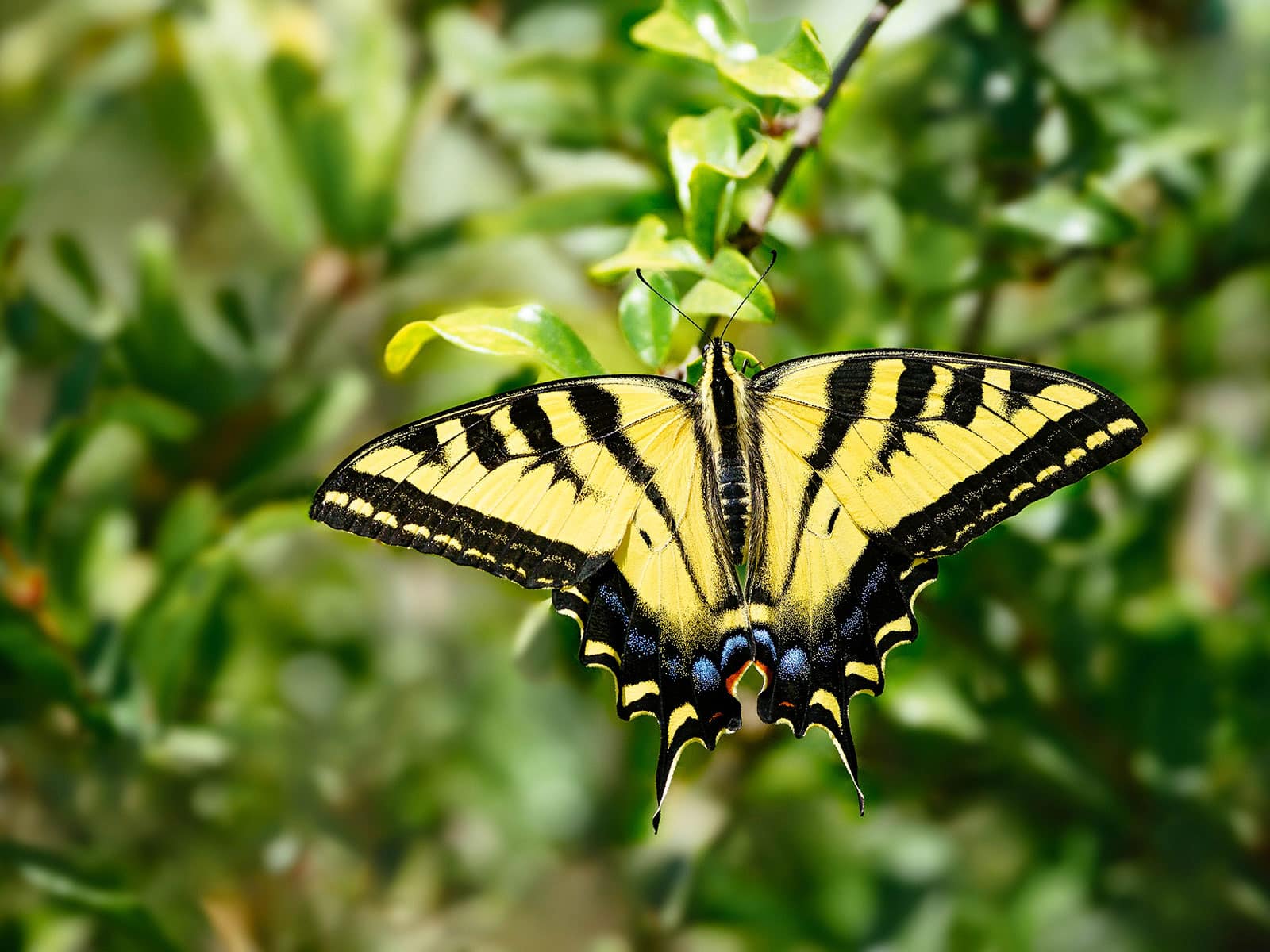
No worries, westerners—you guys get a swallowtail as well! In fact, the western tiger swallowtail looks almost identical to its eastern cousin at a glance, although the tiger stripe pattern on its wings differs slightly.
The western swallowtail can be found from as far north as southern British Columbia to as far south as Baja California in Mexico. It likes all sorts of habitats, particularly those with plenty of moisture, and will often stray into parks and gardens.
Caterpillar: Looks just like that of the eastern tiger swallowtail; green or brown in color with eye spots. Host plants include willow, ash, cottonwood, aspen, and various other trees.
Giant swallowtail (Papilio cresphontes)

Say hello to the largest butterfly in North America! Unlike its aforementioned cousins, the giant swallowtail is black with some yellow (rather than yellow with some black). The males can acquire a wingspan of almost 7 1/2 inches!
This species is found in much of the US and beyond, with its range basically forming a diagonal line from southern California to southeastern Canada. The species likes forested areas, but since it’s not very picky about nectar sources, you shouldn’t have too much trouble getting it to visit your yard.
Caterpillar: Cream and brown marbling? Yep, there’s no way around it; it looks like bird poop.
Did you know?
As beautiful as they are, giant swallowtails (or their caterpillars, anyway) are considered pests by citrus farmers. They just love munching on any plant in the citrus family, including the ones we grow for food.
Black swallowtail (Papilio polyxenes)

The genus Papilio is the gift that keeps on giving. I can’t even discuss all the North American species here, let alone the gorgeous specimens found in the rest of the world! Let’s finish our look at this genus with the stunning black swallowtail, P. polyxenes.
As its name suggests, the wings of this swallowtail species are mostly black in color. Both males and females feature a pattern of yellow dots, although they’re more pronounced in the boys. The females have a splash of pale blue on their “tail.”
The black swallowtail has a wide range, similar to that of the aforementioned giant swallowtail but a bit more extensive. It’s found all the way from southern Canada far into South America, with only the northwestern US states being excluded.
Caterpillar: Called the parsley worm, as it likes plants in the parsley family and can be found feeding on fennel, carrots, and many other garden herbs. It’s green with black stripes and orange dots.
Genus Vanessa
Red admiral (Vanessa atalanta)
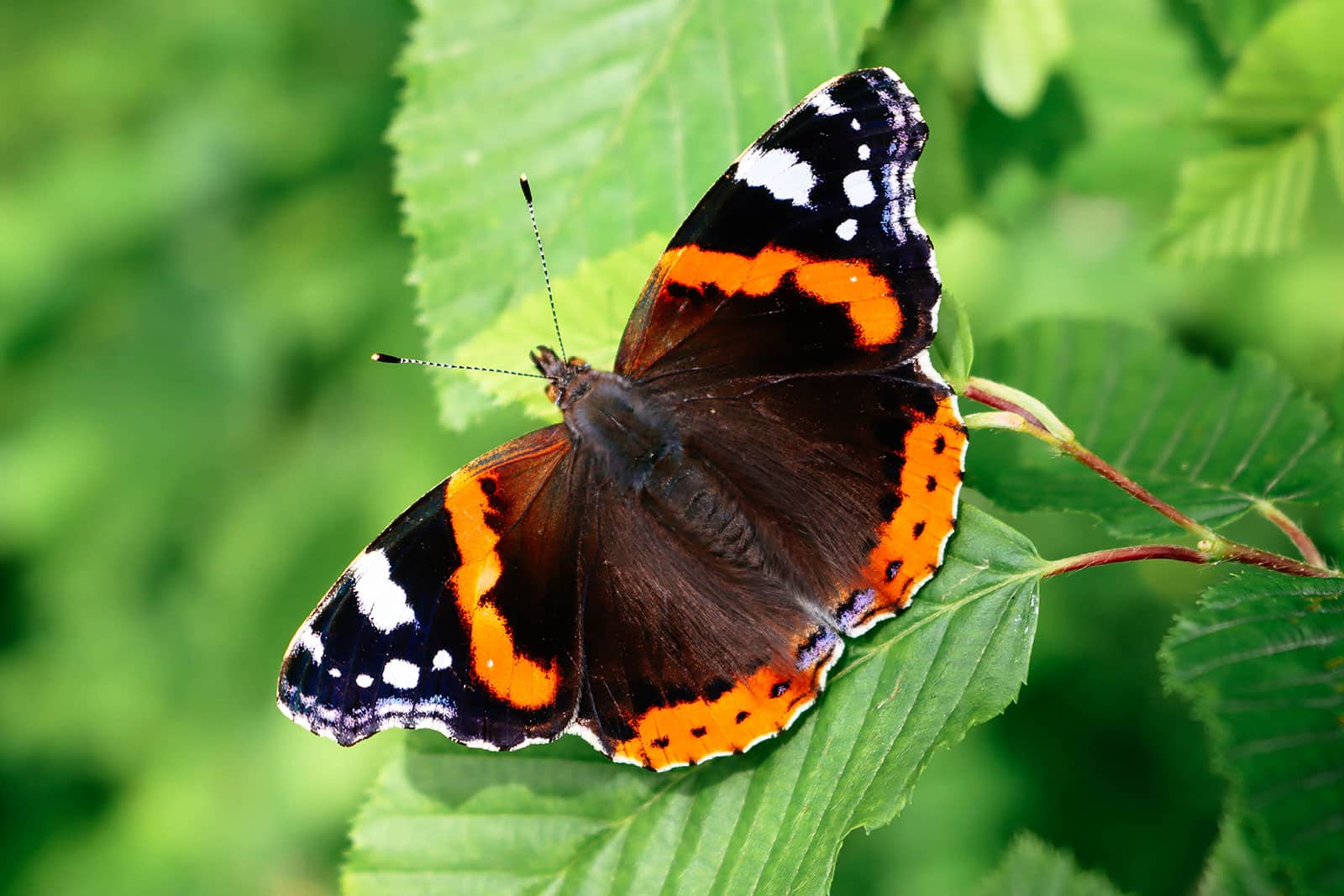
The genus Vanessa, also known as the lady butterflies, is one of the most commonly spotted in backyards. Of its 22 members, the red admiral (V. atalanta) is probably the most frequently observed. With its dark brown to black wings splashed with deep orange and dots of white, it’s definitely hard to miss!
The red admiral has a wide natural range. It can be found throughout all of the United States, as well as much of Canada, Mexico and pretty much the entirety of Europe. It likes woodlands, but because it loves feeding on butterfly bushes and other garden flowers, it’s not difficult to attract to your yard.
Caterpillar: Brown and spiky. It almost exclusively feeds on (stinging) nettle plants.
Did you know?
Like some other butterfly species, the red admiral is territorial. Males occupy perching spots and wait for females to fly by. They defend their territories from intruders by trying to outmaneuver them in a complicated sort of flying dance.
Painted lady (Vanessa cardui)
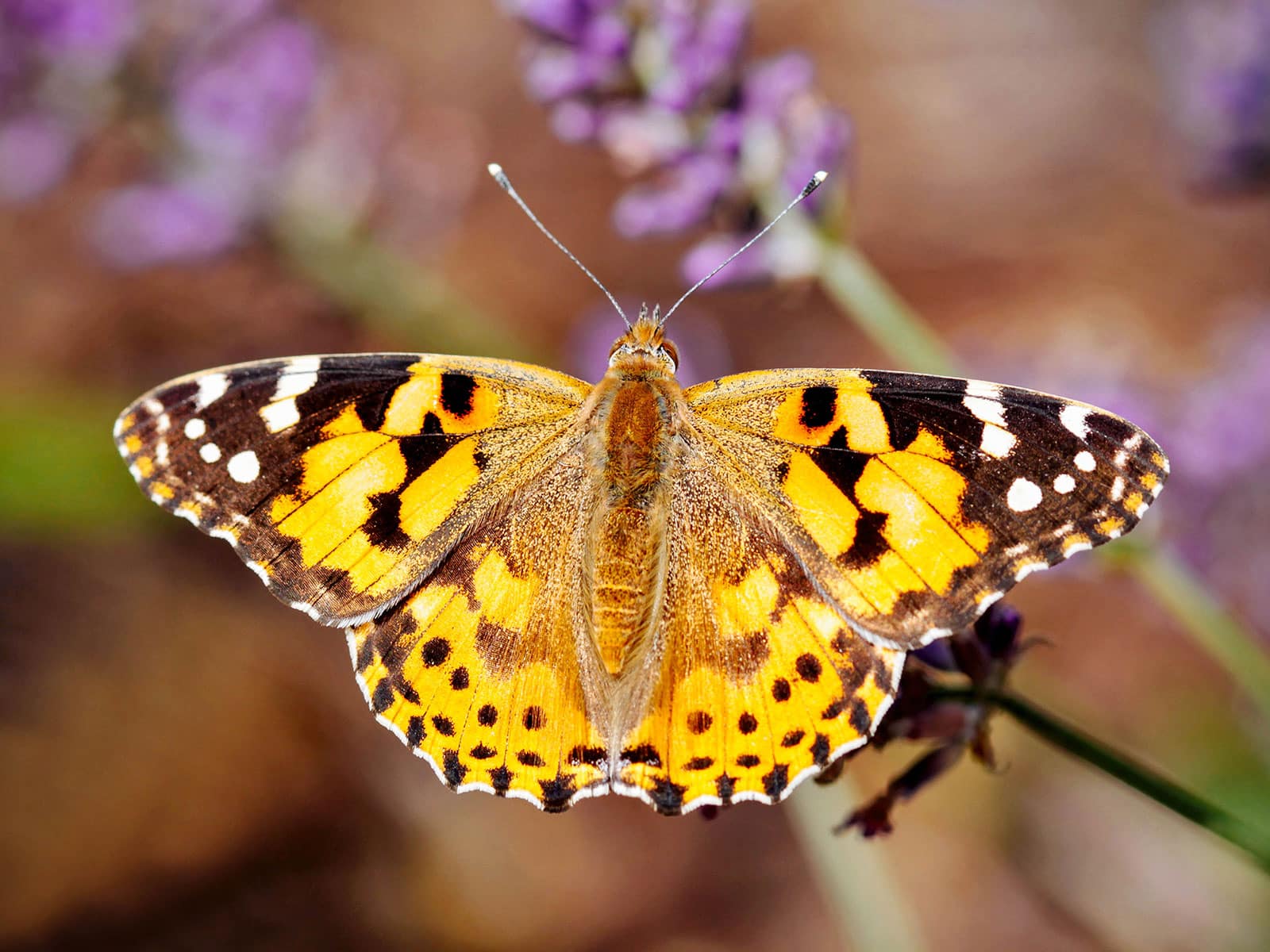
Imagine a red admiral, but with the dark coloration on its wings turned into bright orange. That’s the painted lady! This beautifully patterned species is one of the most widespread butterflies, occurring pretty much everywhere except South America.
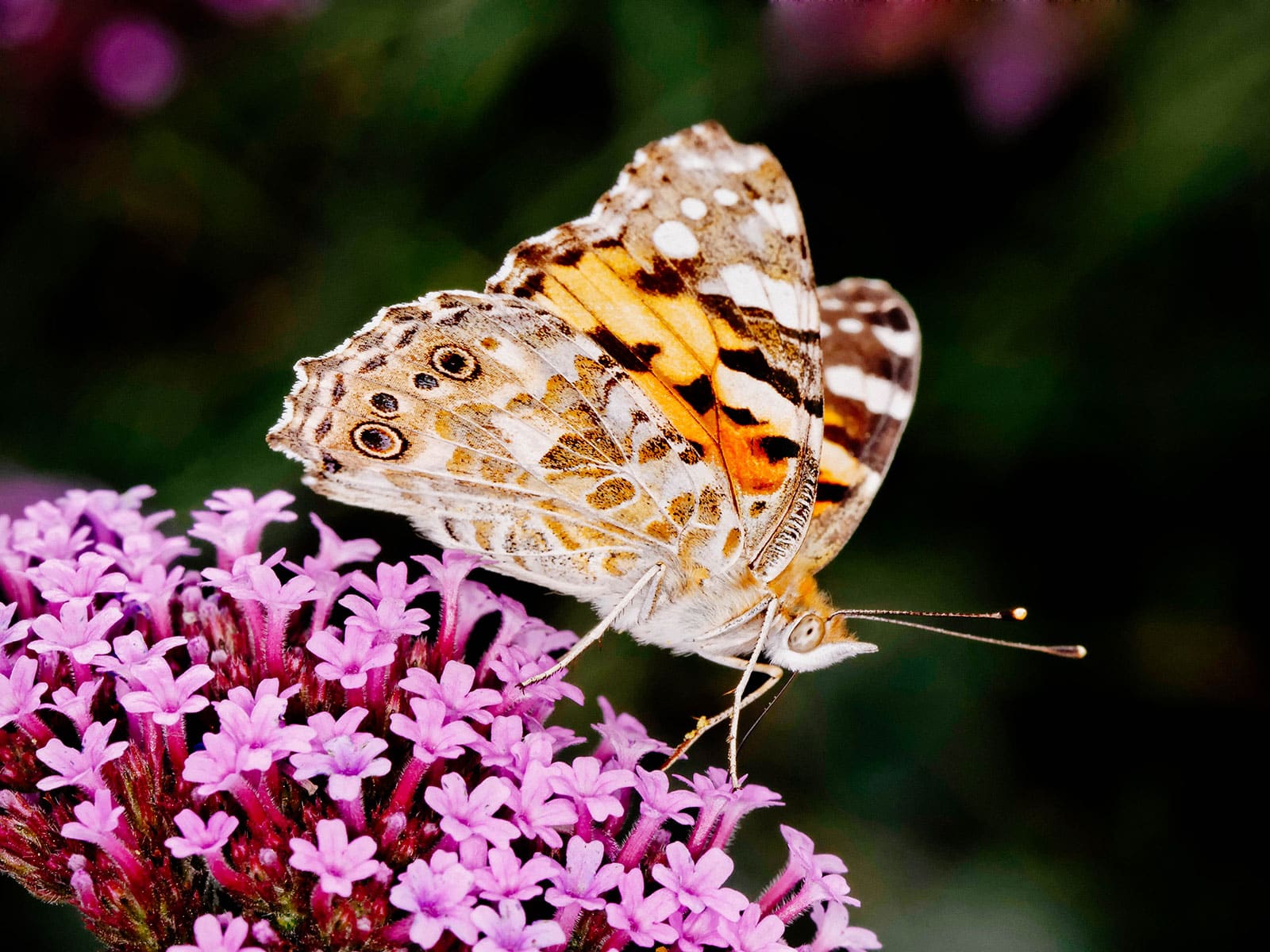
The painted lady is a migratory species that overwinters in warm locations and then moves to cooler zones when the weather allows it. In the summer months, it can be found throughout the US. Like many of the other species on this list, it’s easy enough to attract to your garden, as it’s not picky about host and food plants at all.
Caterpillar: Brown and spiky with a back stripe. It weaves a sort of silky nest around itself for protection, making it easy to recognize.
American lady (Vanessa virginiensis)
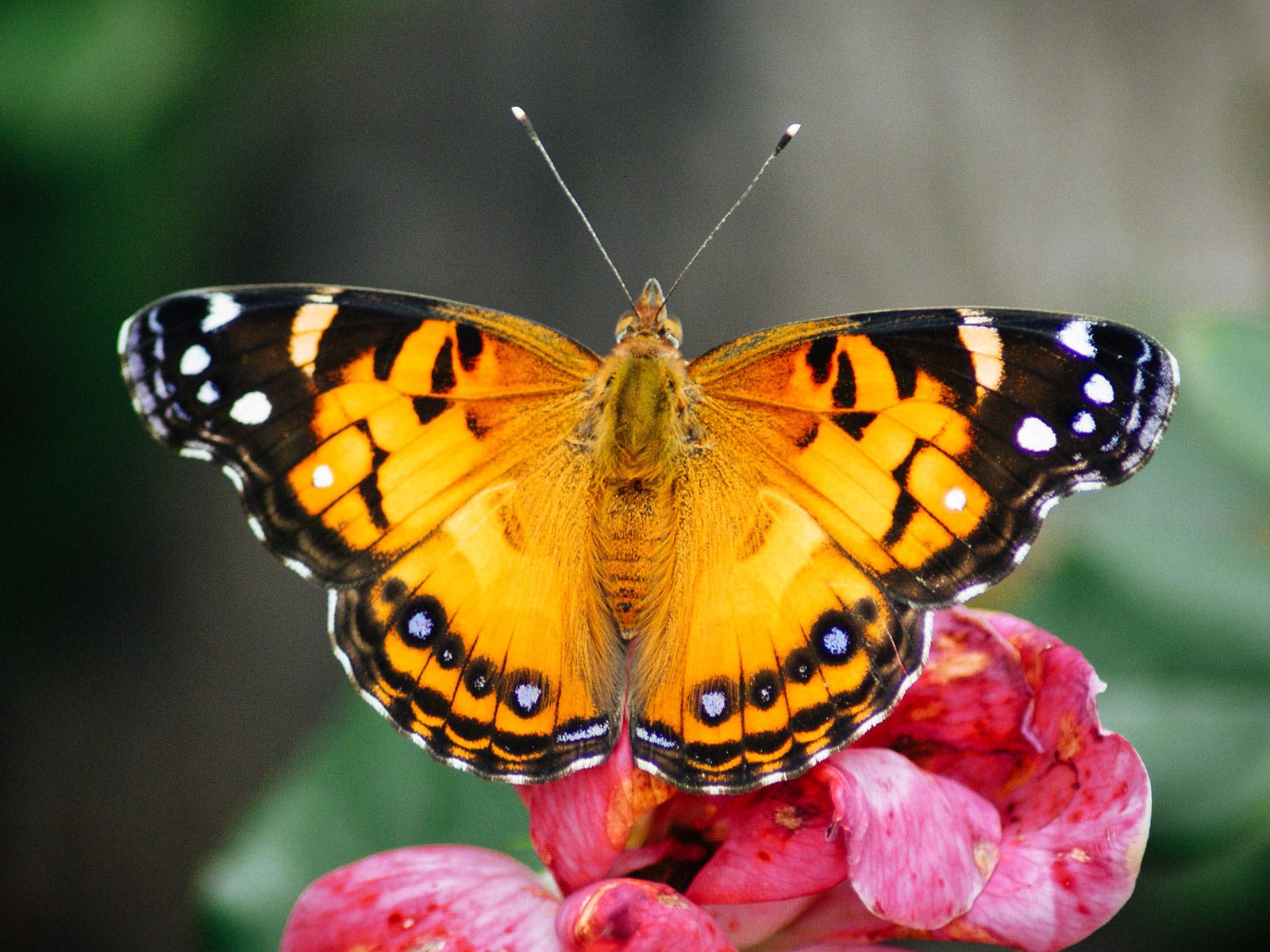
No worries, you’re not seeing double: the American lady, Vanessa virginiensis, does look very similar to its aforementioned painted lady cousin. Once you can tell these apart, you can truly call yourself an expert at backyard butterfly identification!
If you’re unsure which you’re dealing with, there are a few indicators, though most of them are pretty subtle. The easiest course of action is to wait until the butterfly you’ve spotted closes its wings. V. virginiensis has two large eyespots on the bottom (ventral) side of the wings to confuse predators, while V. cardui has four much smaller ones.
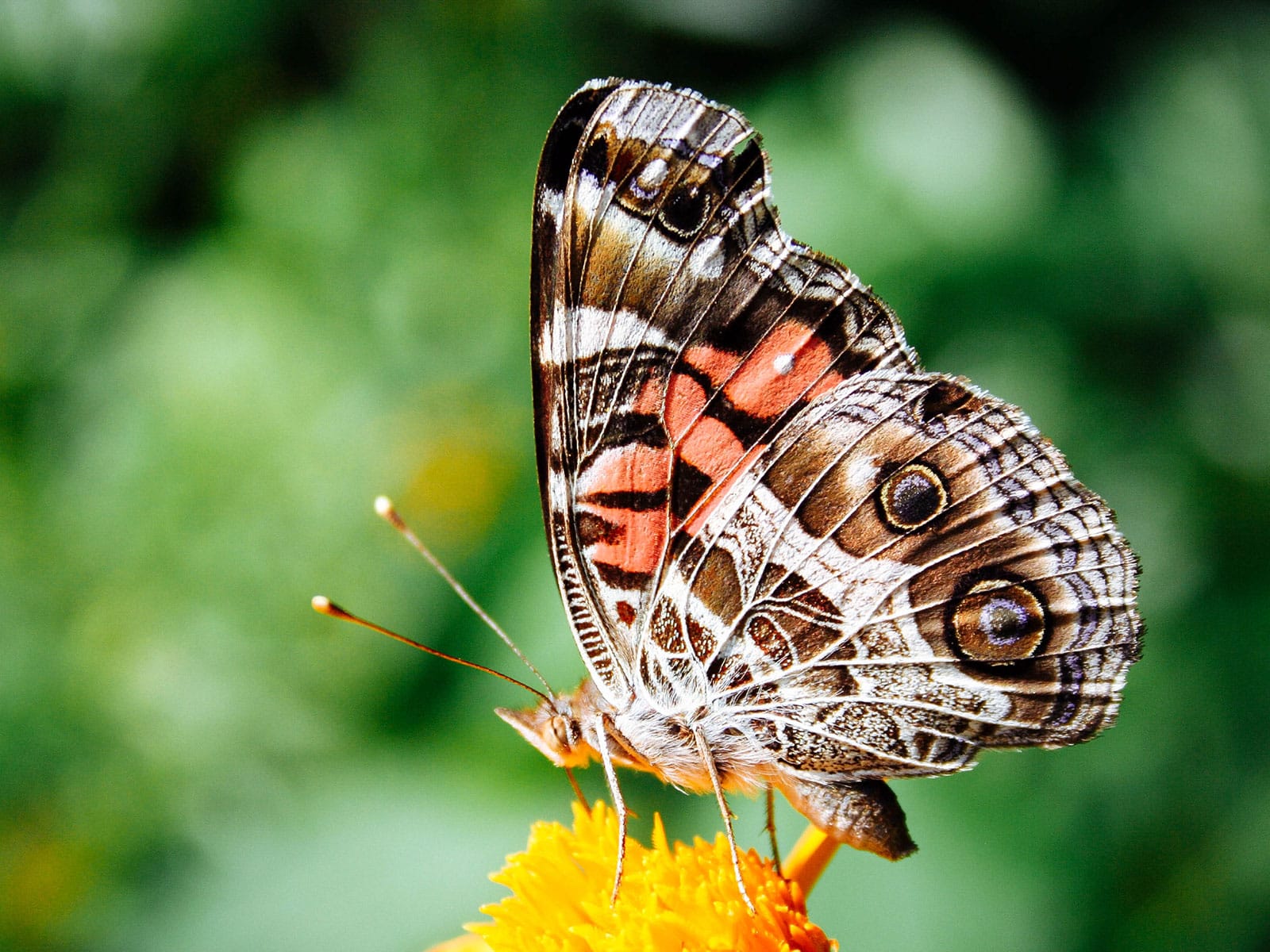
As its name suggests, the American lady butterfly can be found throughout temperate North America (in Hawaii, it’s an introduced species). It also pops up in Macaronesia, the various Atlantic islands off the African coast. It likes open habitats where plants in the daisy family, Asteraceae, can be found.
Caterpillar: Spiky and with alternate dark and light bands, plus twin rows of white spots on its back. It likes plants such as pussytoes and cudweed.
Genus Polygonia: the commas
Question mark (Polygonia interrogationis)
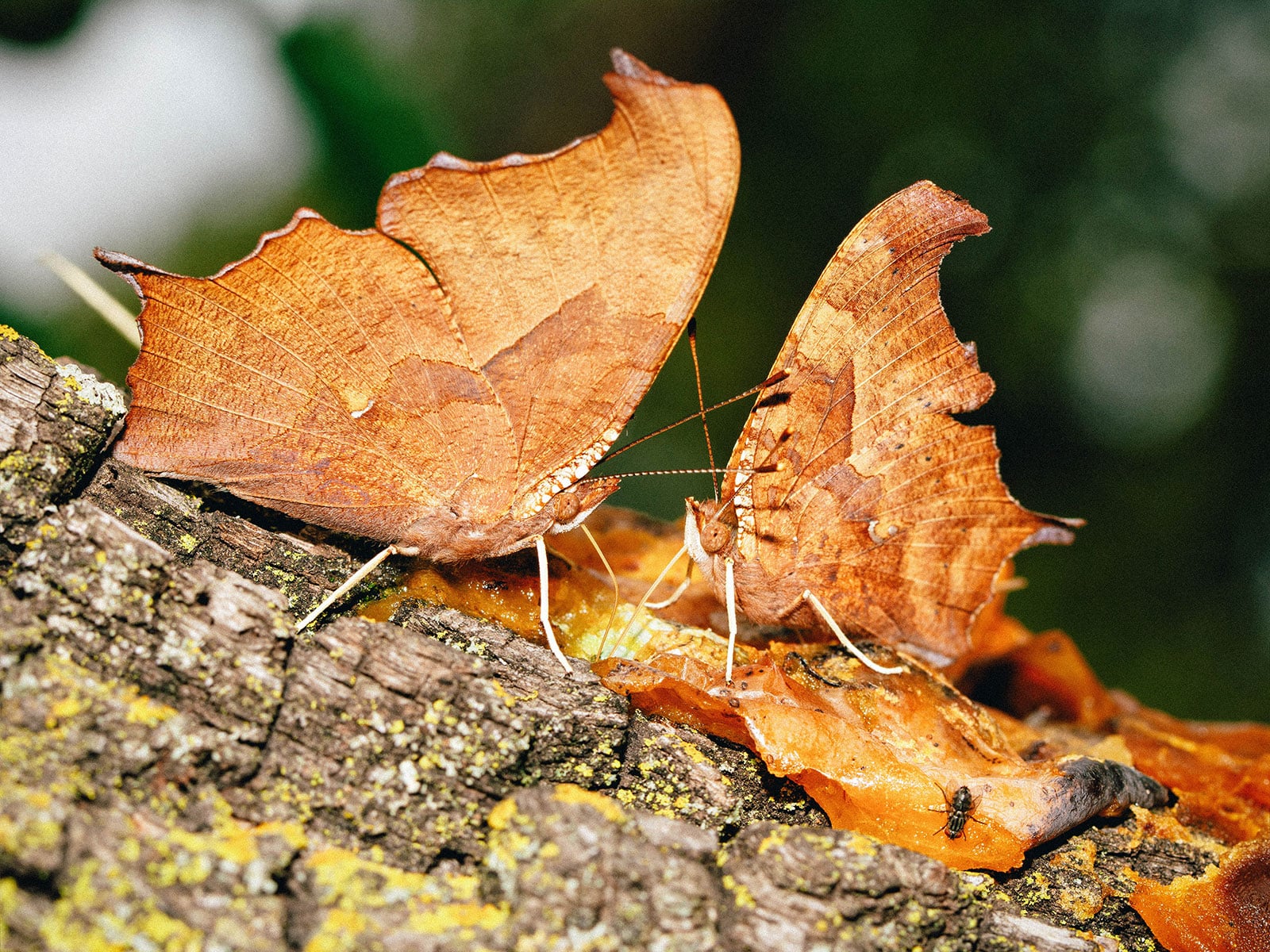
Thought you saw a dead leaf, but it turned out to be a butterfly with closed wings? Plenty of butterflies have evolved to look like dead foliage when they’re at rest, but the question mark (Polygonia interrogationis) is particularly well-camouflaged. When it opens its wings, though, prepare for an explosion of beautiful orange-reddish tones.
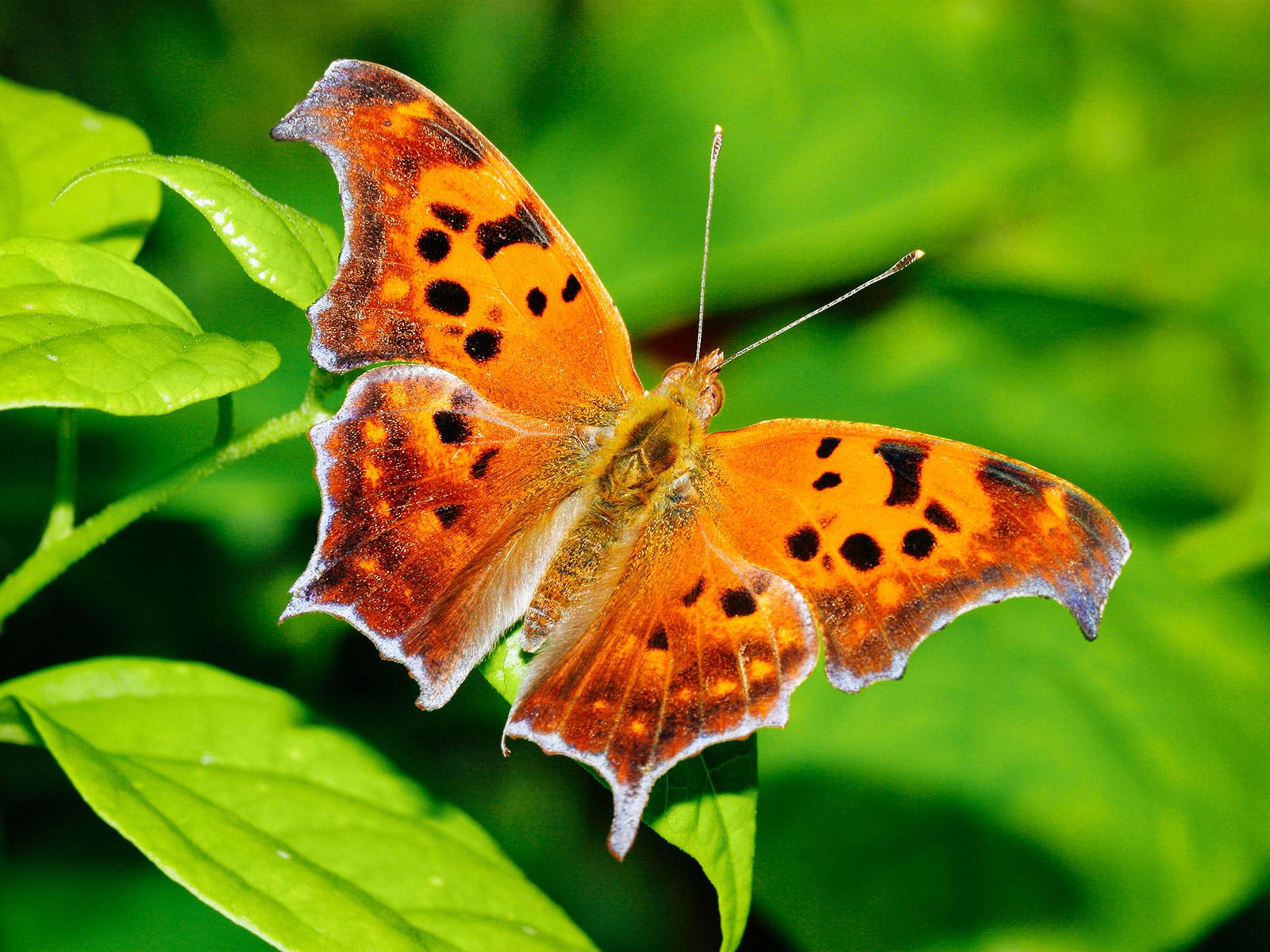
Naturally found throughout the eastern United States and into Mexico, this species lends its odd name from the tiny silver marking on the bottoms of its wings. It’s supposed to look a little like a question mark, although I have to admit I don’t quite see it!
Question marks like woodland with some open space. They’re not very fussy, avoiding nectar and mostly feeding on “trash” (rotting fruit, dung, dead animals). This explains why they frequently wander into parks and gardens, especially if there are fruit trees present.
Caterpillar: Reddish-brown with branched spikes. It eats a variety of plants, including (false) nettles and elm.
Did you know?
Butterfly appearance is quite versatile. In many species, individuals that hatch in spring look different from those that hatch in late summer. This is called seasonal dimorphism. “Summer-form” question marks, for example, sport a black shadow on the lower part of their wings.
Eastern comma (Polygonia comma)
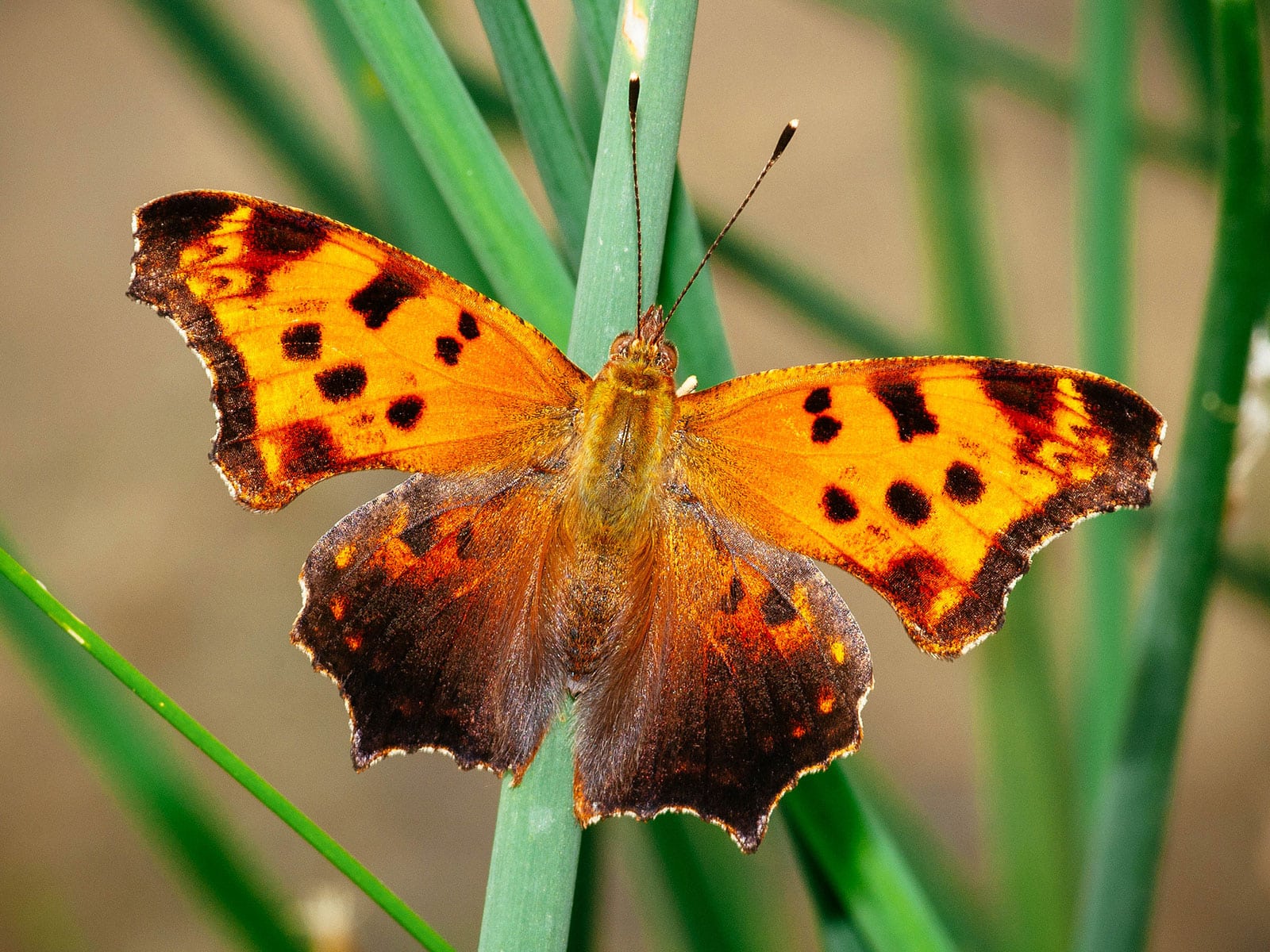
Yes, the members of the genus Polygonia really are all named after punctuation marks. Most of them are referred to as commas due to the “C” shape of the small white mark on the bottom of their wings. Particularly common in the US is the eastern comma.

Found in the eastern half of the country and into the southeastern regions of Canada, the eastern comma (Polygonia comma) can be difficult to distinguish from the aforementioned question mark (P. interrogationis). Another good test for your butterfly identification skills!
Look at the wings when they’re closed: the small spot that gives these species their names is uninterrupted in the comma. In the question mark, it has a tiny separated dot—like a question mark, get it?
The eastern comma appreciates moist areas where water can be found nearby, like streams, marshes and urban ponds. Like its question mark cousin, it doesn’t really feed on flowers. Instead, it prefers rotting fruit, tree sap, and dung.
Caterpillar: Extremely varied in color, so it can be a bit tricky to identify. It has branched spines and can be pale green, black with pale green appendages, or even half orange and half white. It eats a variety of plants, including hops, nettle, and birch.
Genus Colias: the sulphurs
Orange sulphur (Colias eurytheme)
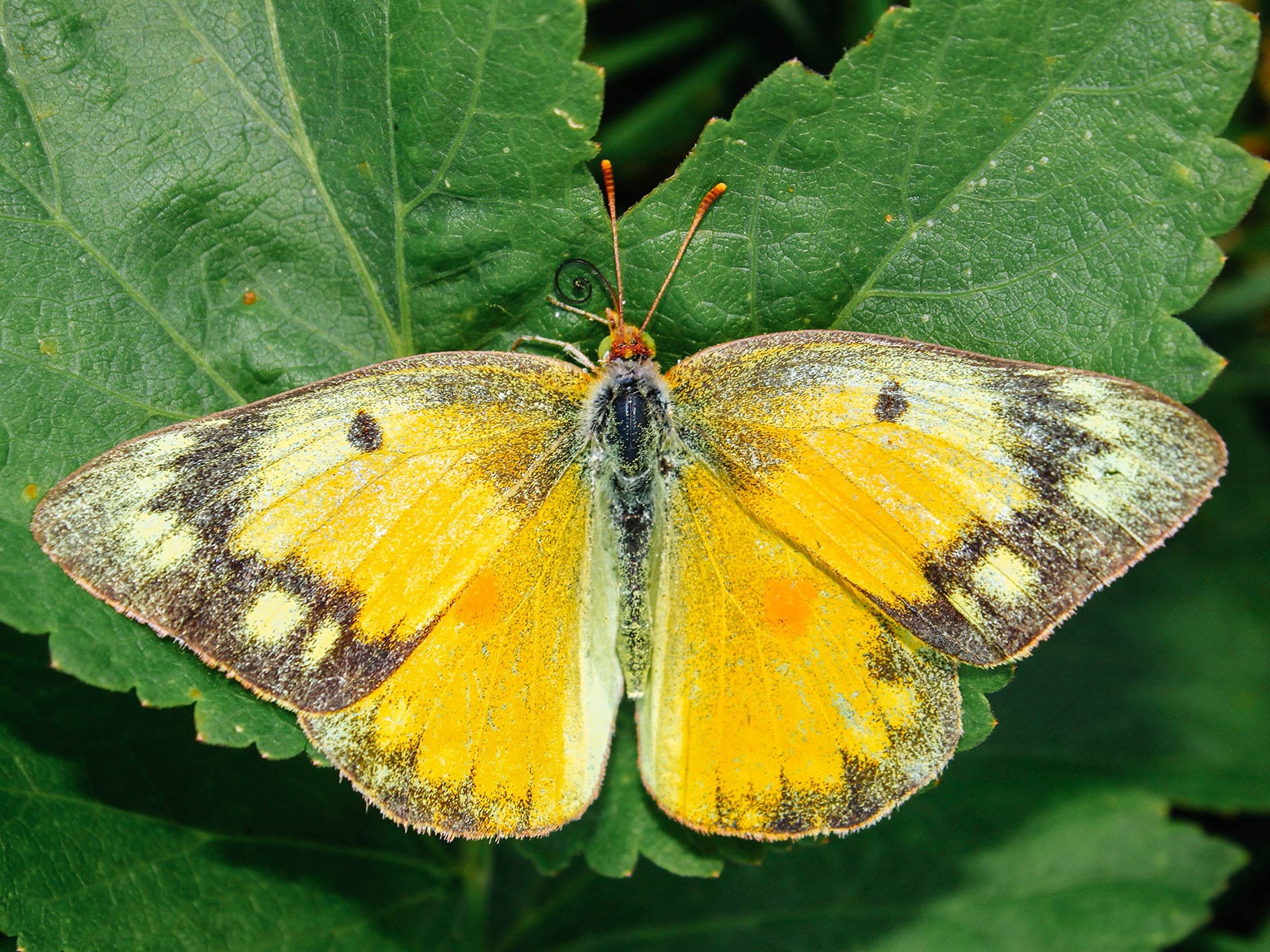
Most butterflies have camouflage colors on the bottoms of their wings, meaning they look much more vibrant when their wings are open than when they are closed. With the orange sulphur, though, I just can’t figure out whether I like the more dramatic upper wing with its black margins or the pink-rimmed, bright yellow underside more!
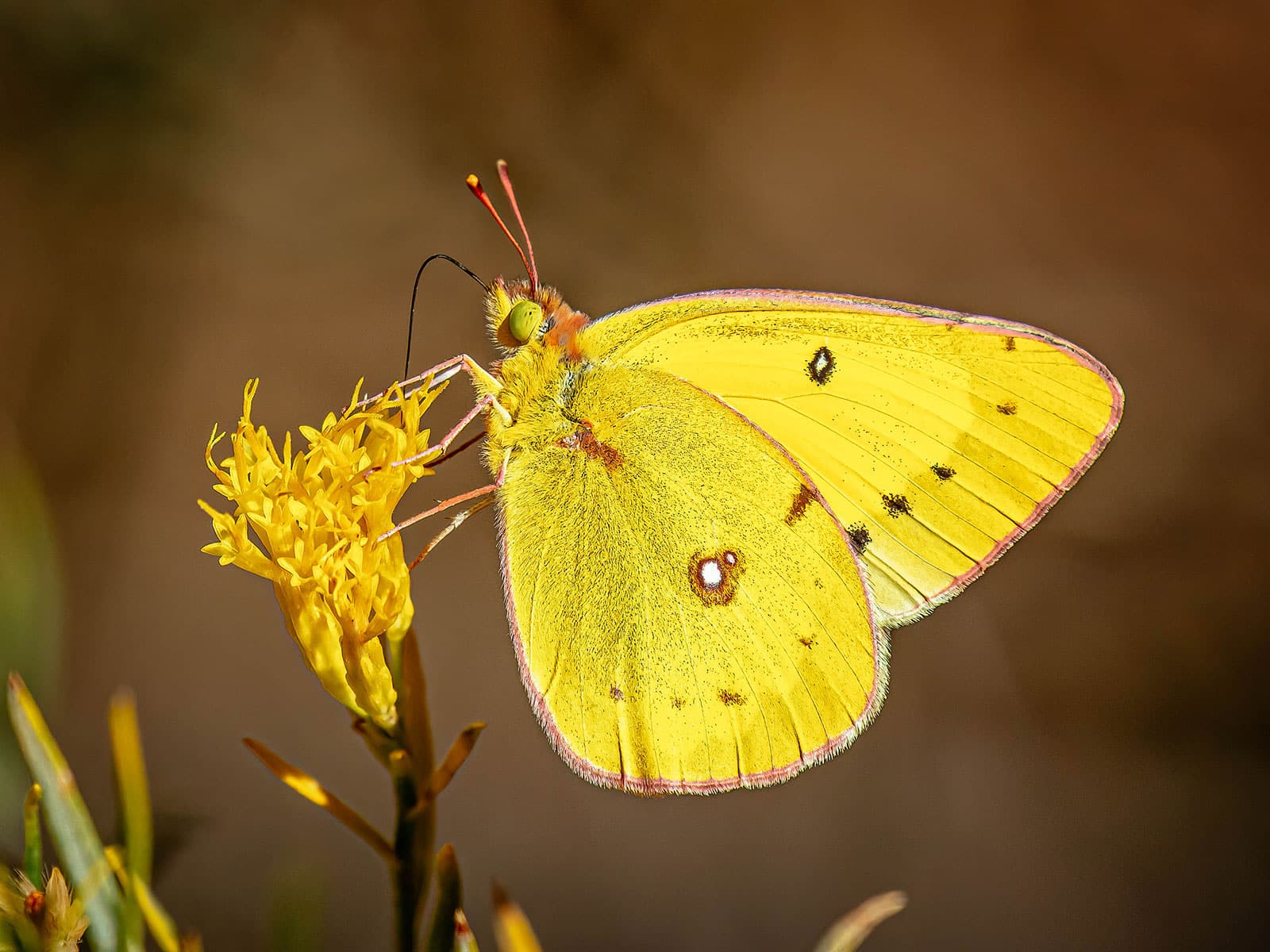
Found everywhere in the US, plus deep into Mexico and Canada, the orange sulphur is a common garden butterfly. It naturally occurs in meadows and fields where plants in the pea family Fabaceae can be found, as that’s what their caterpillars eat. If you grow peas, alfalfa or similar, they’re sure to pop up in your yard.
Caterpillar: Considered a pest by alfalfa farmers. Smooth and green with a light stripe along the side of the body.
Did you know?
About the alfalfa thing: apparently these butterflies used to occur only in the western US. It’s thought that when humans began large scale alfalfa farming in the United States and beyond, this allowed them to expand their range way to the east.
Clouded sulphur (Colias philodice)
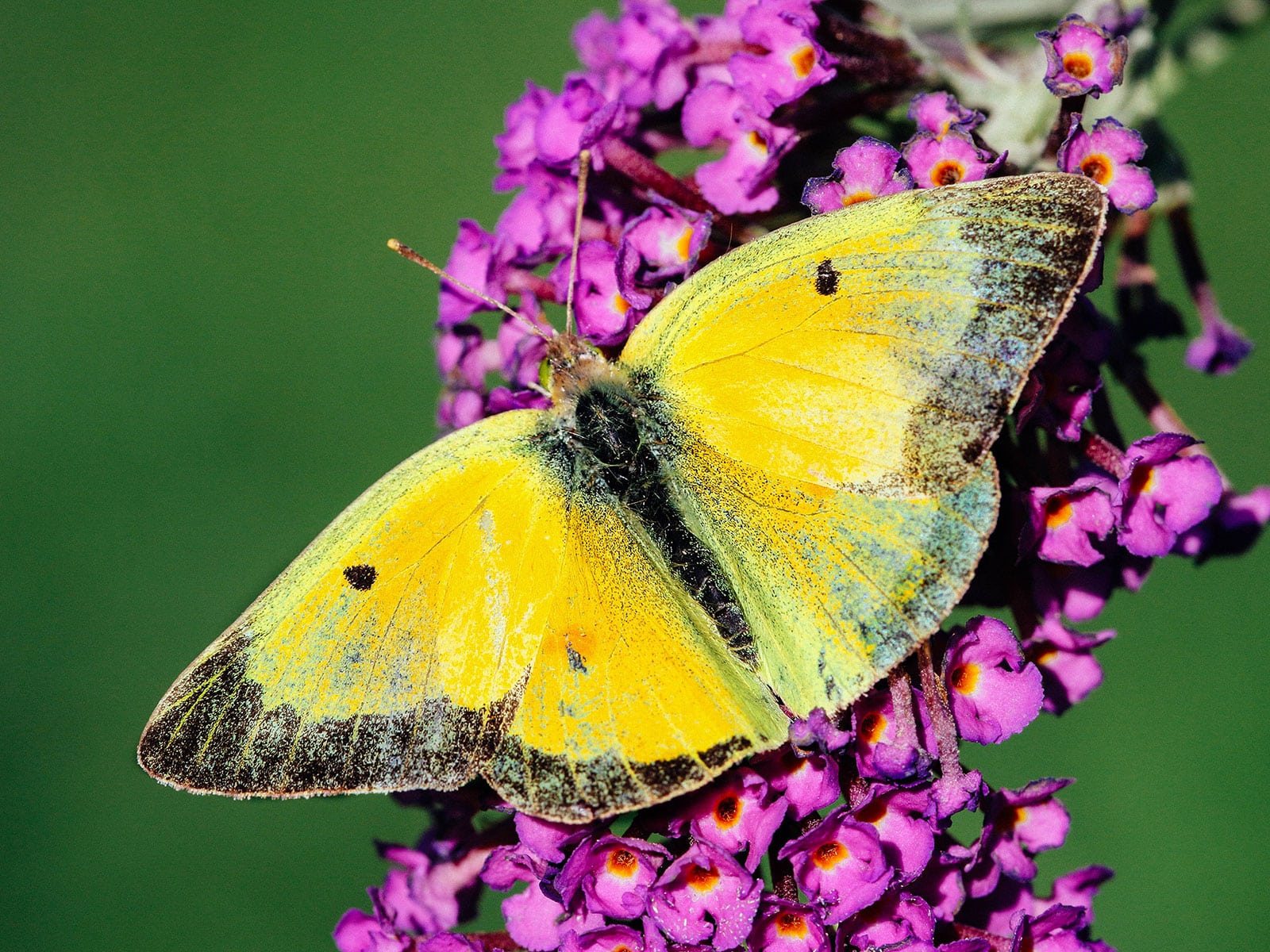
Another beautiful sulphur butterfly species is the clouded sulphur, Colias philodice, which can be differentiated by its yellowish wings (rather than the orange seen on the aforementioned C. eurytheme). While they look very similar, the orange coloration on an orange sulphur is more obvious when it’s in flight. There’s also a white form that occurs in females only, called “alba” (which means “white” in Latin).
As with its orange sulphur cousin, the clouded sulphur’s caterpillars love plants in the pea family. The adults eat nectar from various other meadow flowers, including dandelions, clover, and milkweed. Given how common these are as garden plants, it’s not difficult to attract clouded sulphurs to your yard.
Caterpillar: Very similar to that of C. eurytheme. Green in color with a lighter side stripe, and feeds on plants in the pea family.
Did you know?
Figuring out sulphur butterfly history and evolution has proven a bit of a headache for scientists. The species in the genus Colias interbreed and hybridize regularly, making it very difficult to figure out how they’re interconnected.
Genus Limenitis: the admirals
Viceroy (Limenitis archippus)
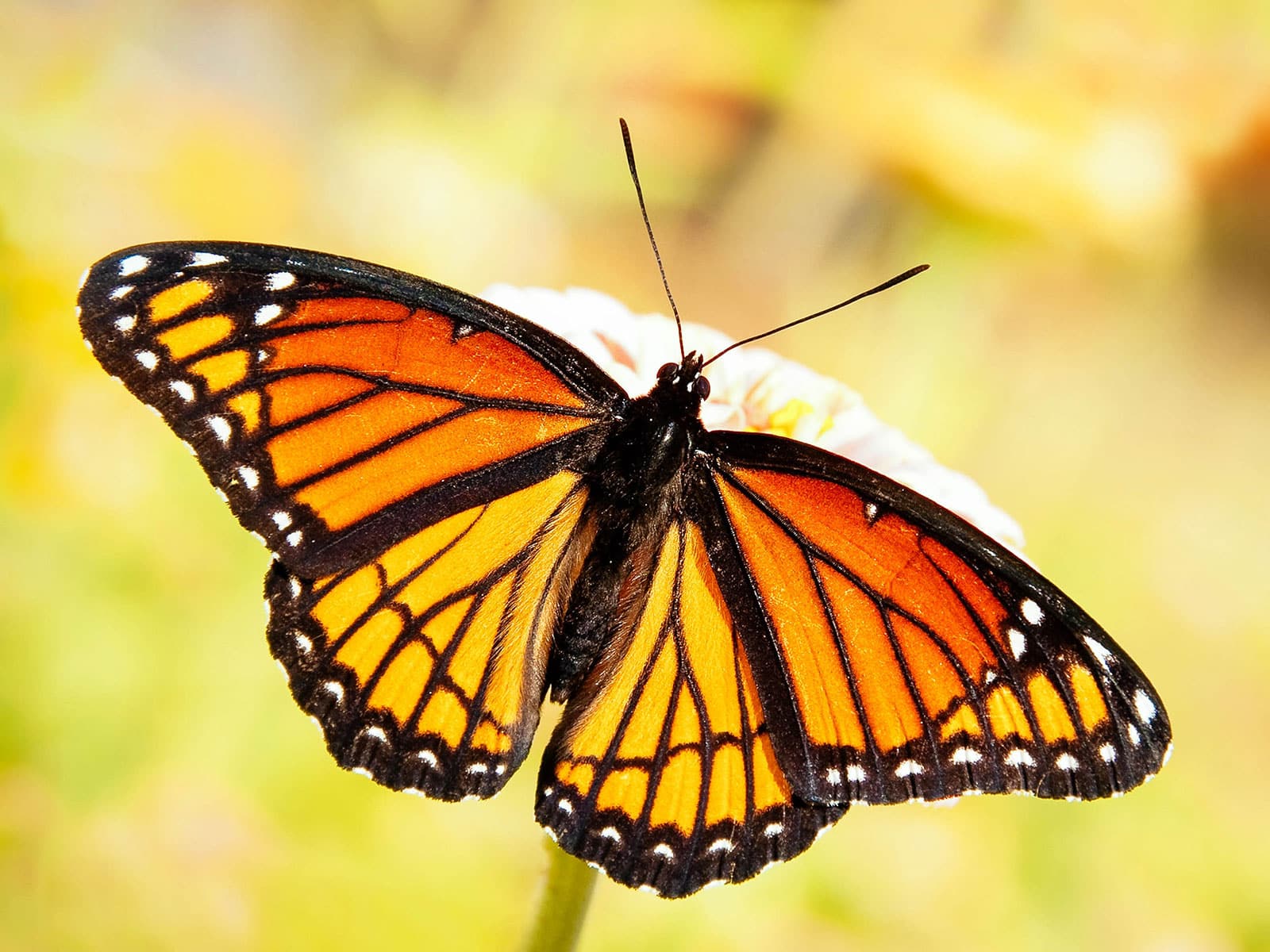
Hold on, is that a monarch butterfly? Nope! But if you want to put your butterfly identification skills to the test, telling a viceroy (Limenitis achippus) from a monarch (Danaus plexippus, discussed under “Miscellaneous Butterflies”) is a pretty darn good place to start. Aside from one little wing stripe, some yellow dots, and a significant size difference, they’re pretty much identical.
The similarity between the viceroy and the monarch is described as Müllerian mimicry, which is when two species that are both distasteful to predators evolve similar looks. If a predator tries to eat a monarch and dislikes the taste, it’s unlikely to try a viceroy after that—and vice versa. This way, both species win.
Viceroy butterflies are found in most of the US (except the westernmost states) plus parts of Canada and Mexico. They hang out in open fields, moist meadows, parks, and gardens, where they feed on various flowers, fruit, aphid honeydew, dung, and more.
Caterpillar: One of those species that mimics bird poop (and does so quite effectively, I might add). It has two “antennae” and feeds on trees in the willow family, which contain the salicylic acid that gives the species its unpleasant flavor.
Did you know?
There are a few other “royal” butterflies that look like monarchs or viceroys. Most notable are the soldier butterfly (Danaus eresimus) and the queen butterfly (D. gilippus). In these species’ ranges, the viceroy is their co-mimic rather than the monarch’s.
White admiral (Limenitis arthemis)
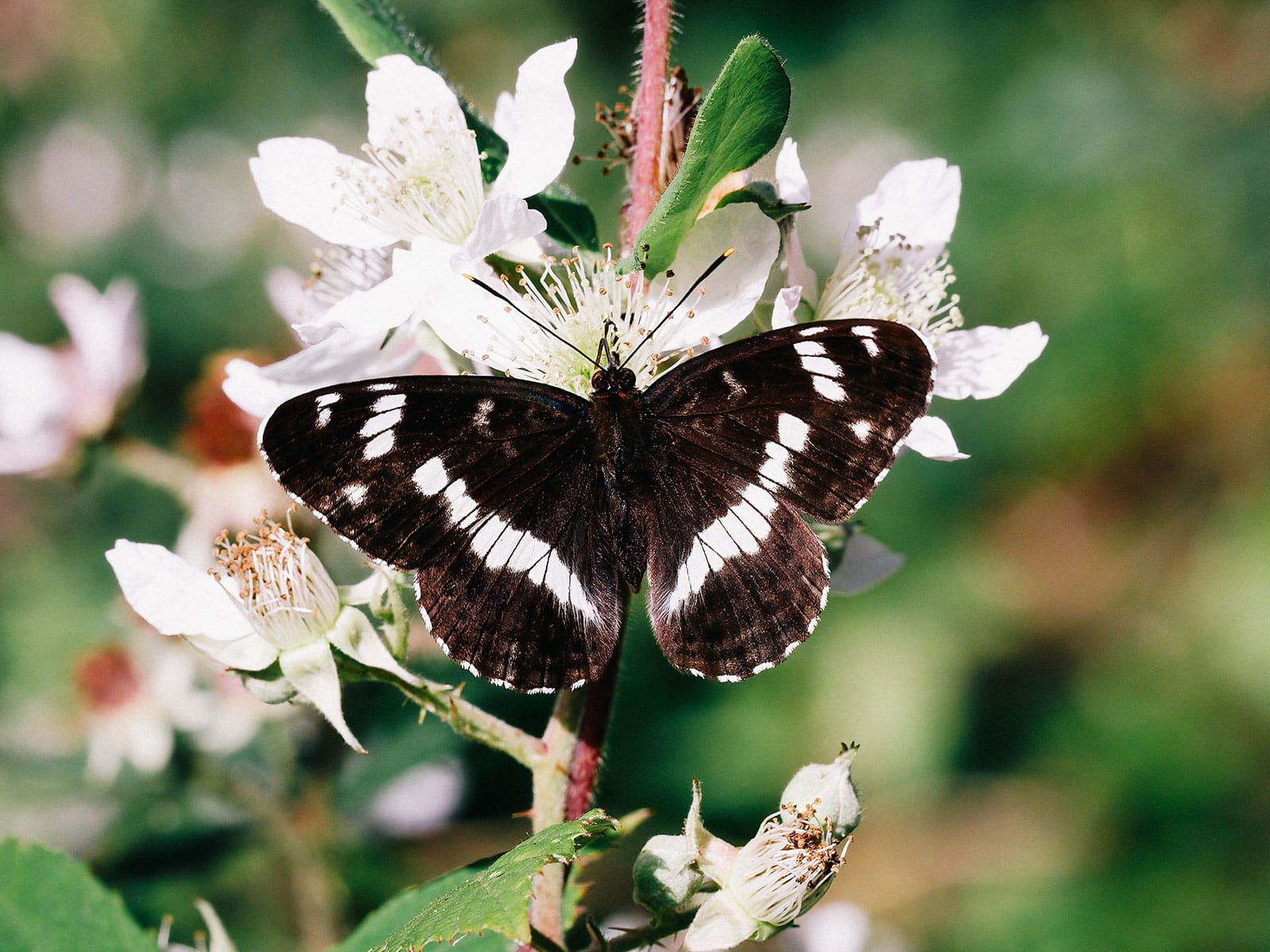
One butterfly that’s particularly easy to identify is the white admiral. Its black wings with striking white bands make it pretty hard to miss! When the wings are closed, bands of orange spots become visible on the edges.
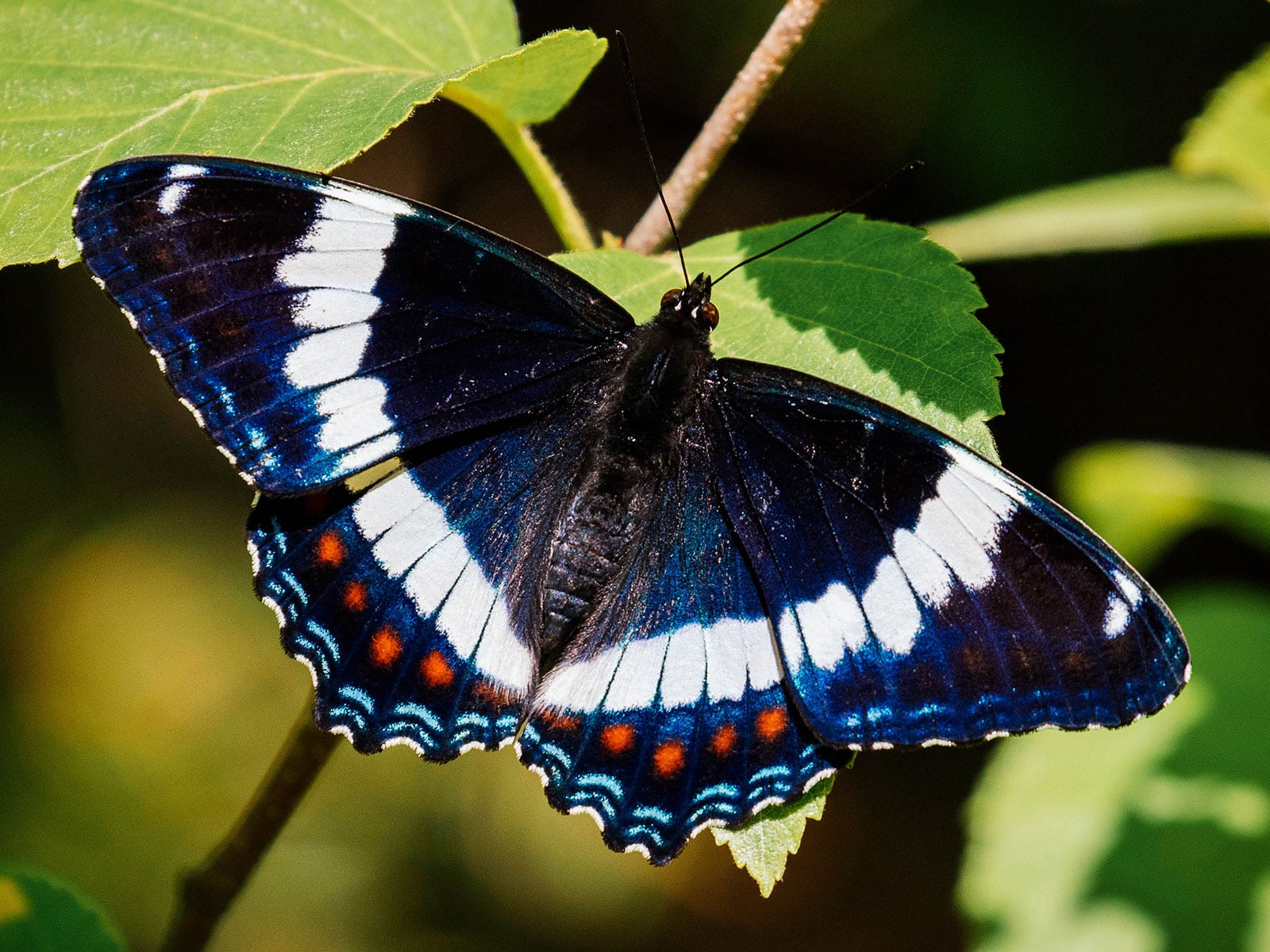
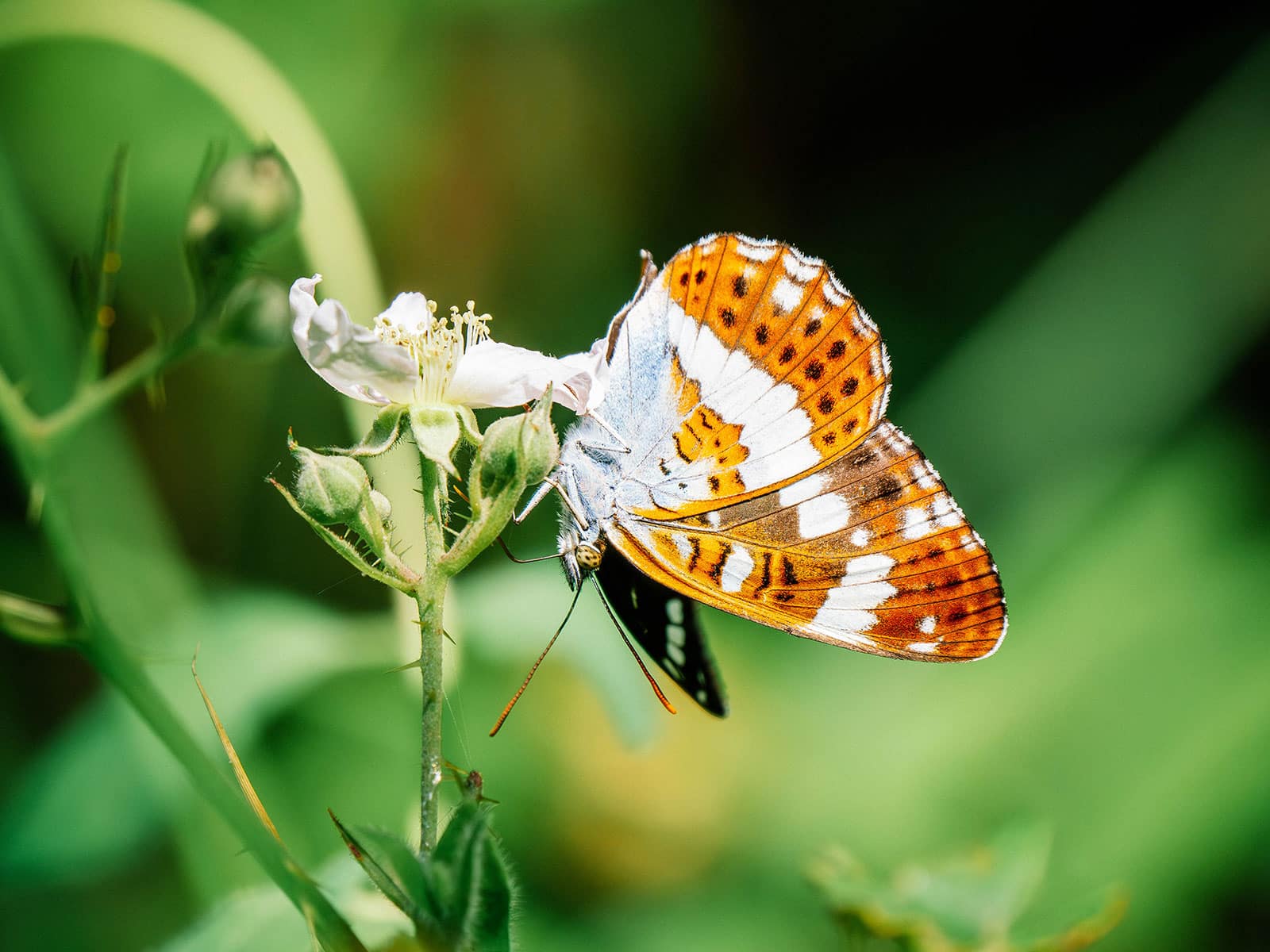
Found in the northern states all the way through Canada and up to Alaska, white admiral butterflies like woodland edges and shaded parks. Because they mainly eat rotting fruit rather than nectar, they’re likely to pop up in your garden if you have fruit trees—or you can attract them by leaving out a plate of leftover fruit.
Caterpillar: Mimics bird poop for protection. It eats the leaves of trees in the willow family, especially some types of birches.
Red-spotted purple (Limenitis arthemis astyanax)

This is the only butterfly on the list that’s a subspecies. The red-spotted purple looks so different from the closely related white admiral that it really does deserve a spot of its own here. It’s gorgeous to look at and doesn’t even seem real with its patterned wings in dark shades of black and blue.
Like the aforementioned viceroy, the red-spotted purple is a mimic. It’s not a Müllerian mimic (which is poisonous or has an unpleasant taste itself), though, but a Batesian mimic. This more common type of mimicry involves a non-poisonous species evolving to look like one that is poisonous, hoping that predators will fall for its visual bluff and leave it alone.
The red-spotted purple imitates the looks of the beautiful blue swallowtail (Battus philenor), which occurs in the same natural range in the southeastern US. It’s not the only one to do so, either; various fellow swallowtails (genus Papilio) also mimic this species, and there’s even a moth that looks pretty similar.
Red-spotted purples like shaded forest edges. The adults feed on some nectar, but prefer tree sap and rotting stuff like fruit and carrion. If you have fruit trees, they’re likely to pass through your yard!
Caterpillar: Typical for the genus, looking like bird droppings. It eats plants in the rose family Rosaceae, including peach and cherry tree leaves.
Did you know?
The white admiral and red-spotted purple’s natural ranges overlap in the Great Lakes region. Here, hybrids between the two subspecies can be found. There’s also a third subspecies, but that one only occurs far away around Arizona and into Mexico.
Miscellaneous butterflies
Monarch butterfly (Danaus plexippus)
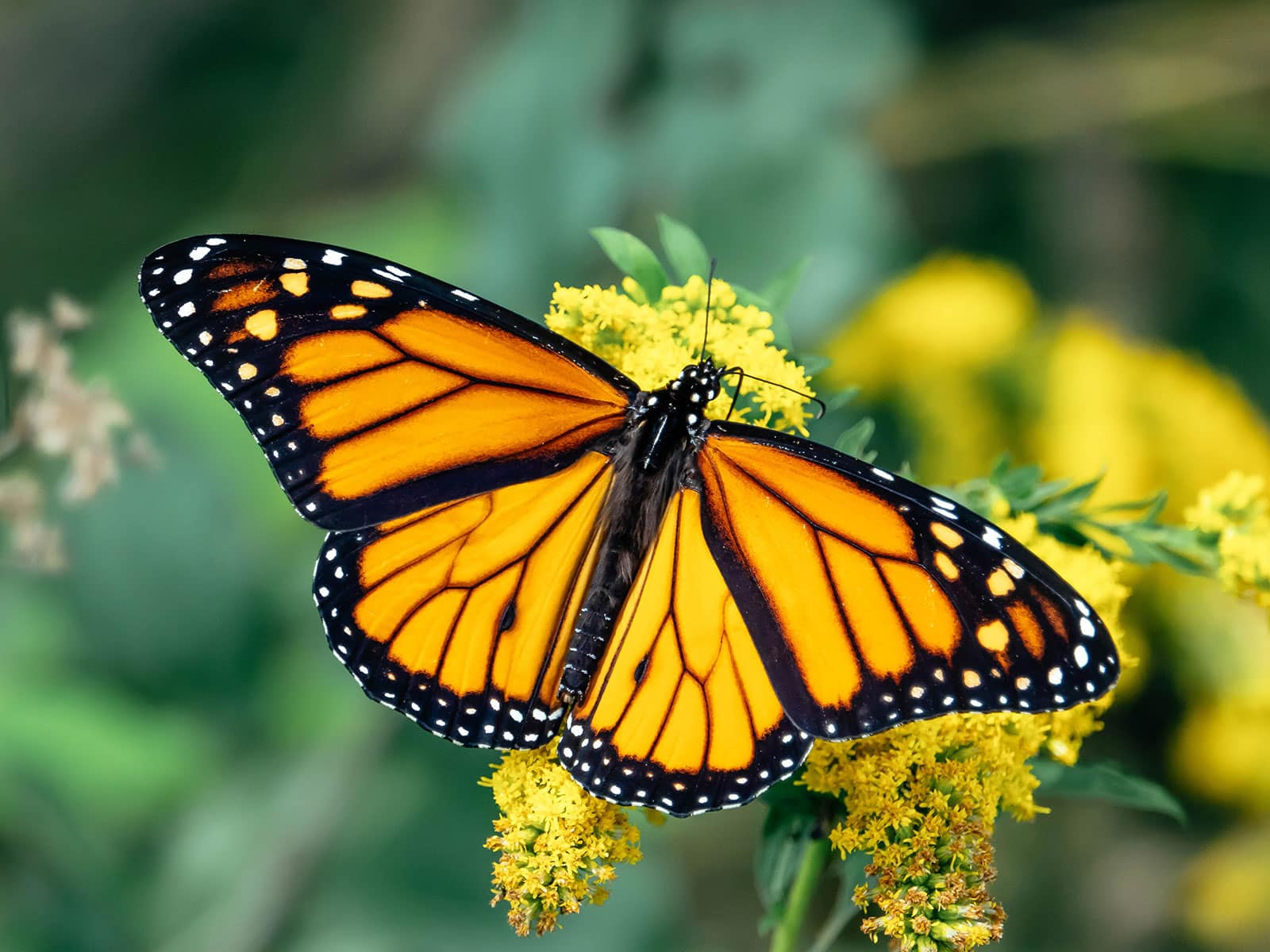
You were probably wondering when I was going to get around to discussing this iconic American species. Well, here it is! Known for its extensive migration pattern, the monarch butterfly occurs in almost all of the US. It moves from the northern and central states down to Florida, California, and Mexico in fall. In spring, it goes all the way back up.
The monarch is very easy to recognize, though as I’ve mentioned, it does look very similar to its mimic, the smaller viceroy butterfly. It has a wingspan up to 4 inches and is characterized by its orange “tiger-striped” wings, which feature a pattern of white polka dots on the edges.
Caterpillar: Quite similar to that of some swallowtails, the monarch caterpillar has a striped pattern of pale green, black, and yellow. It can be distinguished by its antennae. It exclusively feeds on milkweed plants in the genus Asclepias.
Did you know?
Monarch butterflies’ bright colors signal the fact that they taste terrible to most predators. The milkweed the caterpillars eat contain foul-tasting toxins called cardiac glycosides.
Cabbage white (Pieris rapae)
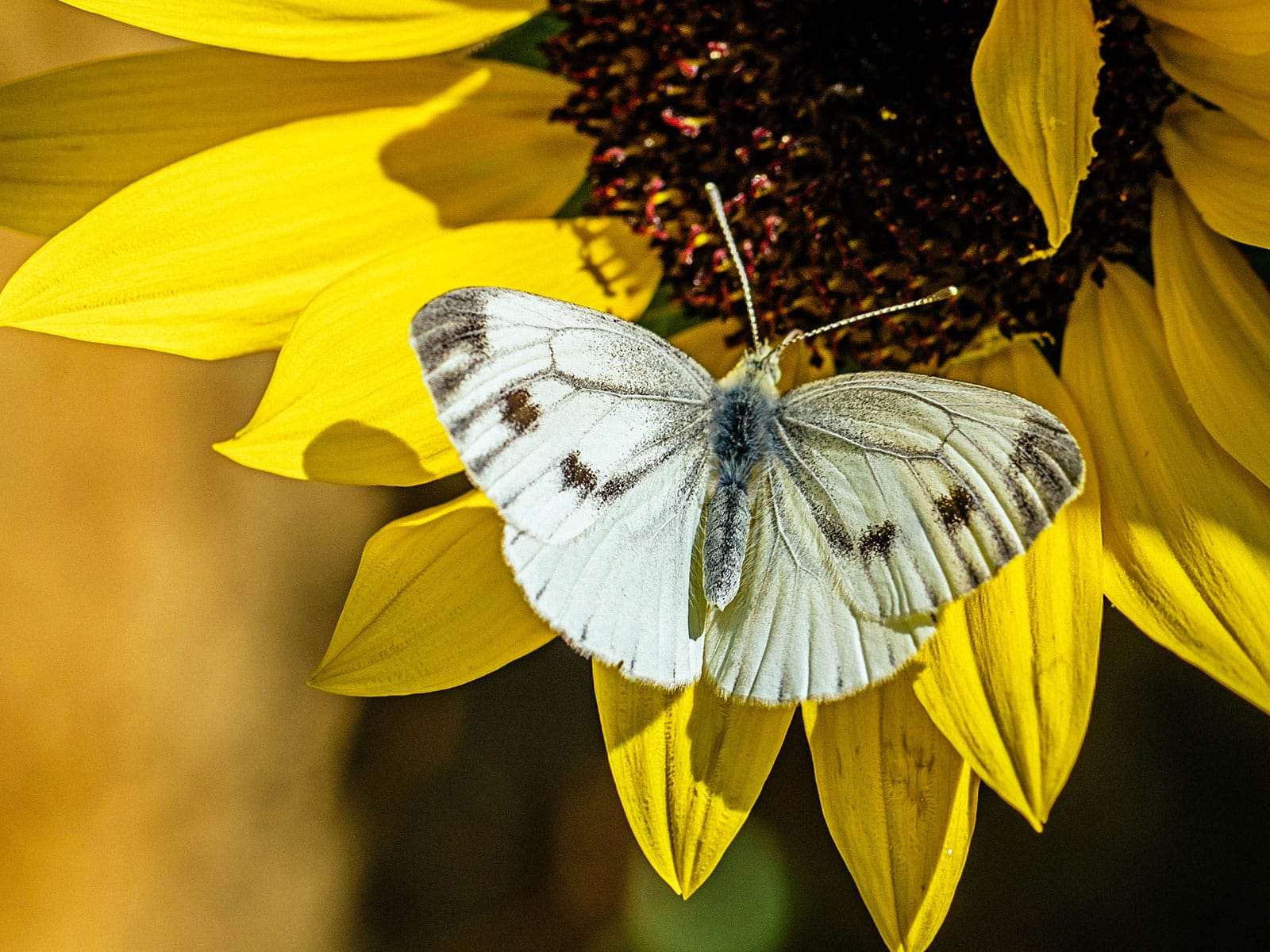
Although the cabbage white is thought to originate from the Mediterranean in Europe, it can now be found throughout much of the world. This includes pretty much all of North America. It’s thought the species’ massive spread was made possible by the fact that humans now grow and eat cruciferous vegetables like cabbage and broccoli, their host plant, almost everywhere.
Cabbage whites are plain-looking but still easy to recognize. They’re small, reaching a maximum wingspan of just under 2 inches, and white in color. The wings have black tips that are more pronounced in the males. Two dots (more pronounced in females) become visible when the wings are open.
You’re very likely to spot cabbage whites in your garden, especially if you grow veggies in the cabbage family. Their caterpillars can be a bit of a pest and are one of the more common green caterpillars found on leafy crops.
Caterpillar: Sometimes known as the imported cabbageworm. It’s small, green in color and slightly velvety. It can be found on cruciferous plants, sometimes in huge numbers that cause massive damage to commercially grown crops.
Mourning cloak (Nymphalis antiopa)

This has got to be one of my personal favorites in terms of looks. The mourning cloak butterfly has reddish-brown wings rimmed with blue dots and a striking cream-colored edge. With a wingspan of up to 4 inches, it’s quite a head-turner.
Common in both northern Eurasia and all of North America, particularly the north, the mourning cloak especially likes mountainous habitats. Like some other butterfly species, the adults aren’t very fond of nectar. They prefer other sweet treats like tree sap, fallen fruits, and aphid honeydew.
Caterpillar: Spiky, black, and with a pattern of dark orange-red dots on its back. It feeds on a variety of plants, like willow, elm, and poplar, forming communal nests covered in silk for safety purposes.
Spring azure (Celastrina ladon)
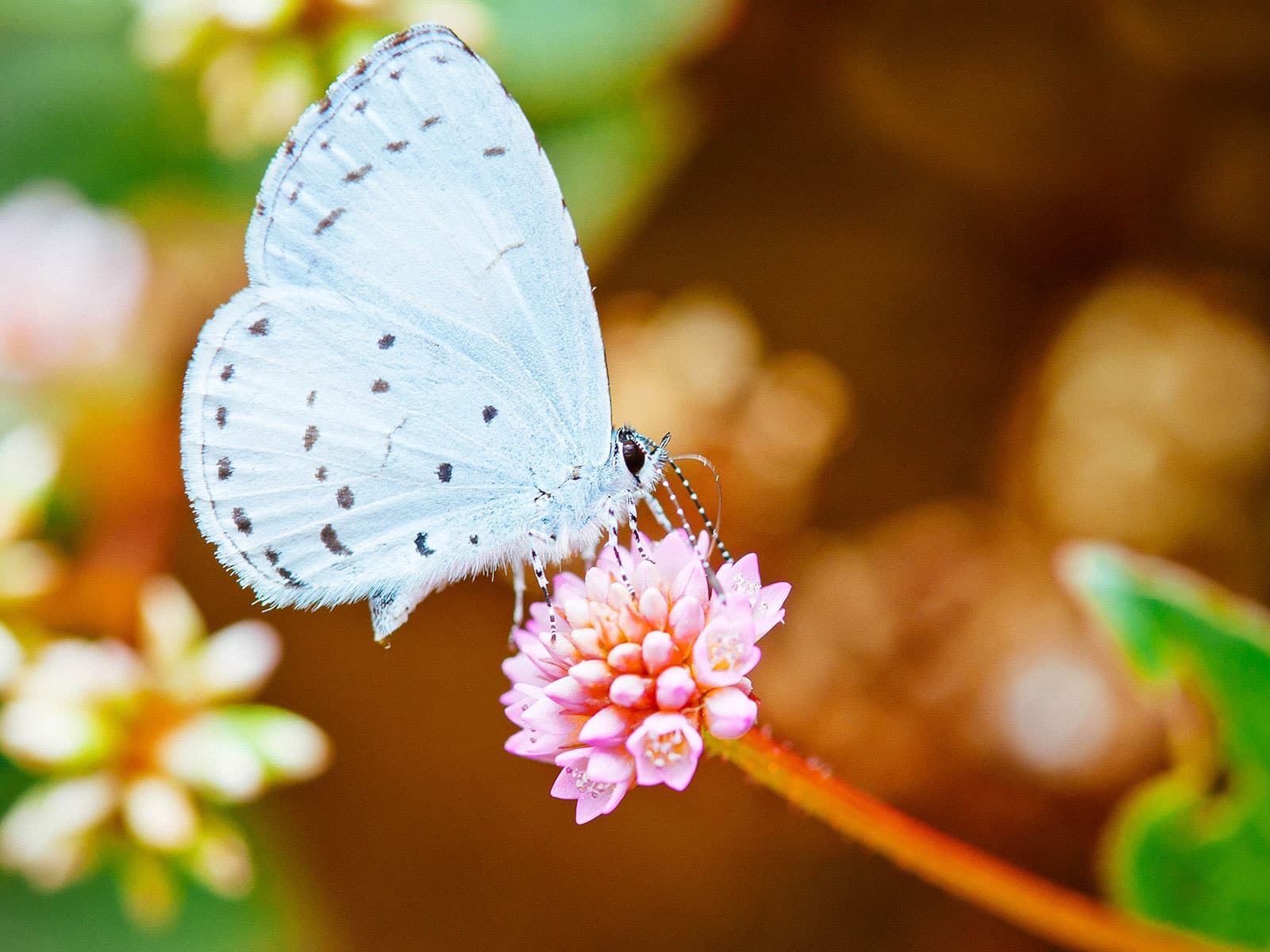
The butterfly genus Celastrina is also known as the blues or azures. There are many different species, including a good number that occur in North America, but the spring azure (Celastrina ladon) is probably the most common.
Found in most of the US except the Texas area and some of Florida, spring azures are small butterflies that reach a maximum wingspan of less than 1 1/2 inches. The wings are a beautiful pale metallic gray to blue in color.
Caterpillar: Compact, (pale) green, and distinctly segmented. It likes woody shrubs, especially dogwood.
Did you know?
Along with the aforementioned question mark, cabbage white, and mourning cloak, the spring azure is one of the earliest butterflies. It tends to appear on the very first sunny days of spring.
Common wood nymph (Cercyonis pegala)
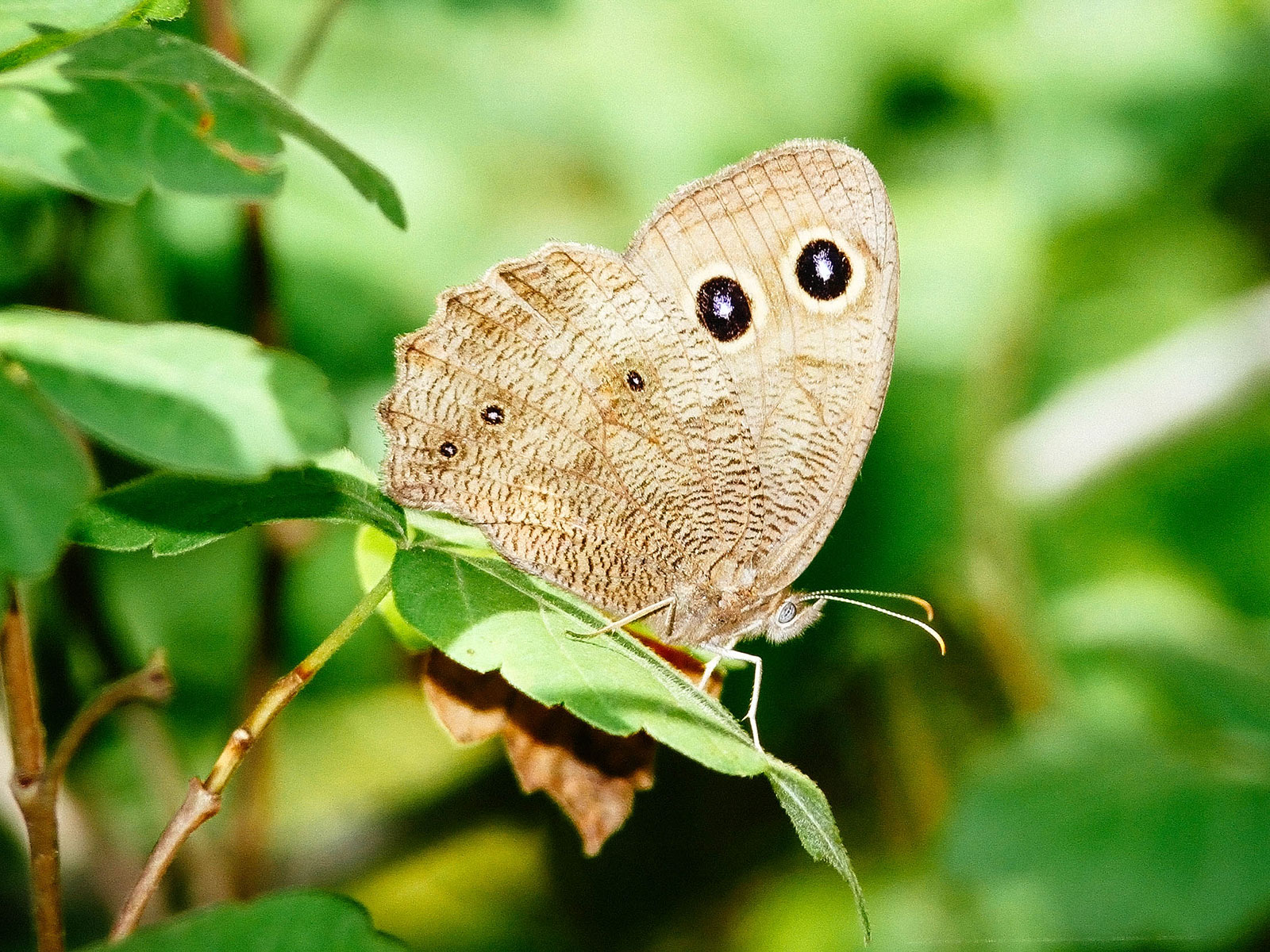
Aren’t butterflies with eyespots on their wings just the coolest? Although they’re meant to confuse and intimidate predators into thinking the butterfly is larger than it really is, they just remind me of peacock feathers. The common wood nymph (Cercyonis pegala), which is a grayish-white in color but has striking eyespots, is a great example.
Found throughout much of the US except the far southwest, the common wood nymph has a whopping 13 subspecies that can all look different (um, not confusing at all!). The double eyespots on the upper wing stay the same, though.
This species is a fan of the nectar of a wide range of different weeds, including thistles, so it’s common in areas where plants are left to grow wild. It’s often seen in open woodland, meadows, prairies, and, indeed, our backyards.
Caterpillar: Green in color and very slightly fuzzy. It feeds on various species of grass.
Common buckeye (Junonia coenia)
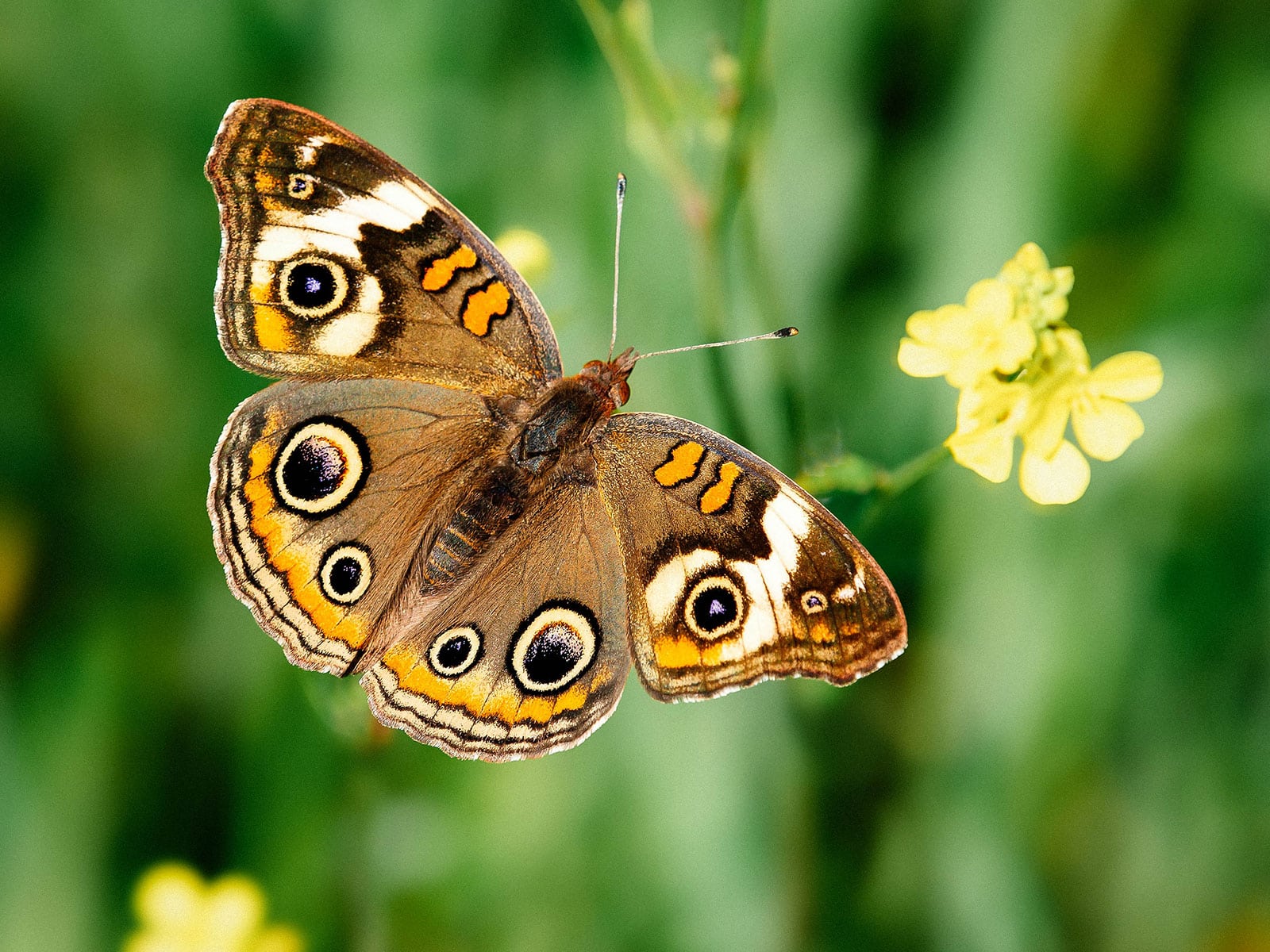
Another butterfly species with gorgeous eyespots is the common buckeye (Junonia coenia), which is living proof that camouflage colors don’t equal boring. With its whopping three spots and an intricate pattern of different shades of (orange-ish) brown, this one’s quite the looker.
The common buckeye is found throughout much of the US, with the exception of the northwest. It likes relatively open habitats that feature a variety of flowers to drink nectar from. It particularly likes lantana, but will also go for clovers and different thistle species.
Caterpillar: Also quite pretty, as far as caterpillars go. It’s black and spiky, with subtle lighter stripes running along the body and some splashes of orange. It eats a variety of plants, especially those in the plantain family Plantaginaceae.
Cloudless sulphur (Phoebis sennae)
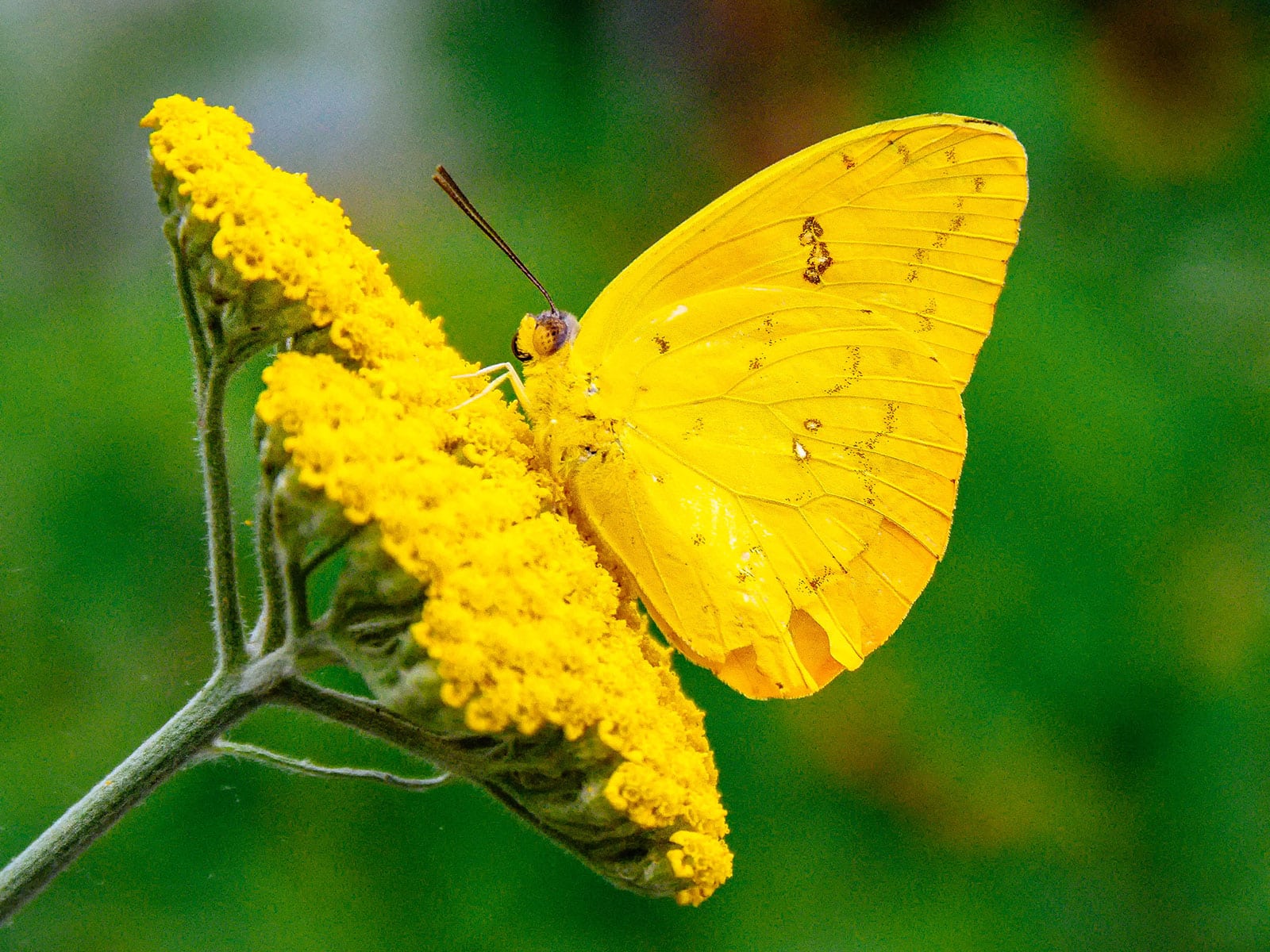
Hold on, didn’t we already discuss the sulphurs a ways back? Well, as confusing as it is, the common name “sulphur” is used for orange to yellow butterflies in a variety of genera in the family Pieridae (which also includes such butterflies as the cabbage white). We had a look at some species in the genus Colias, but this one, the cloudless sulphur, belongs to the genus Phoebis.
The cloudless sulphur, which is yellow in color with a sprinkling of pale pink dots, is found in the Americas as far south as Argentina and all the way up to southern Canada. In the US, it’s mostly common in the southern states, although you may be able to spot it further up north as well. It likes open spaces with some water sources and will also visit gardens.
Caterpillar: Green to yellowish with a peppering of fine black dots. It features a pattern of blue on its sides and can have dark-colored bands. Its favorite foods (clover, sennas, and more) are all in the pea family.
Gray hairstreak (Strymon melinus)
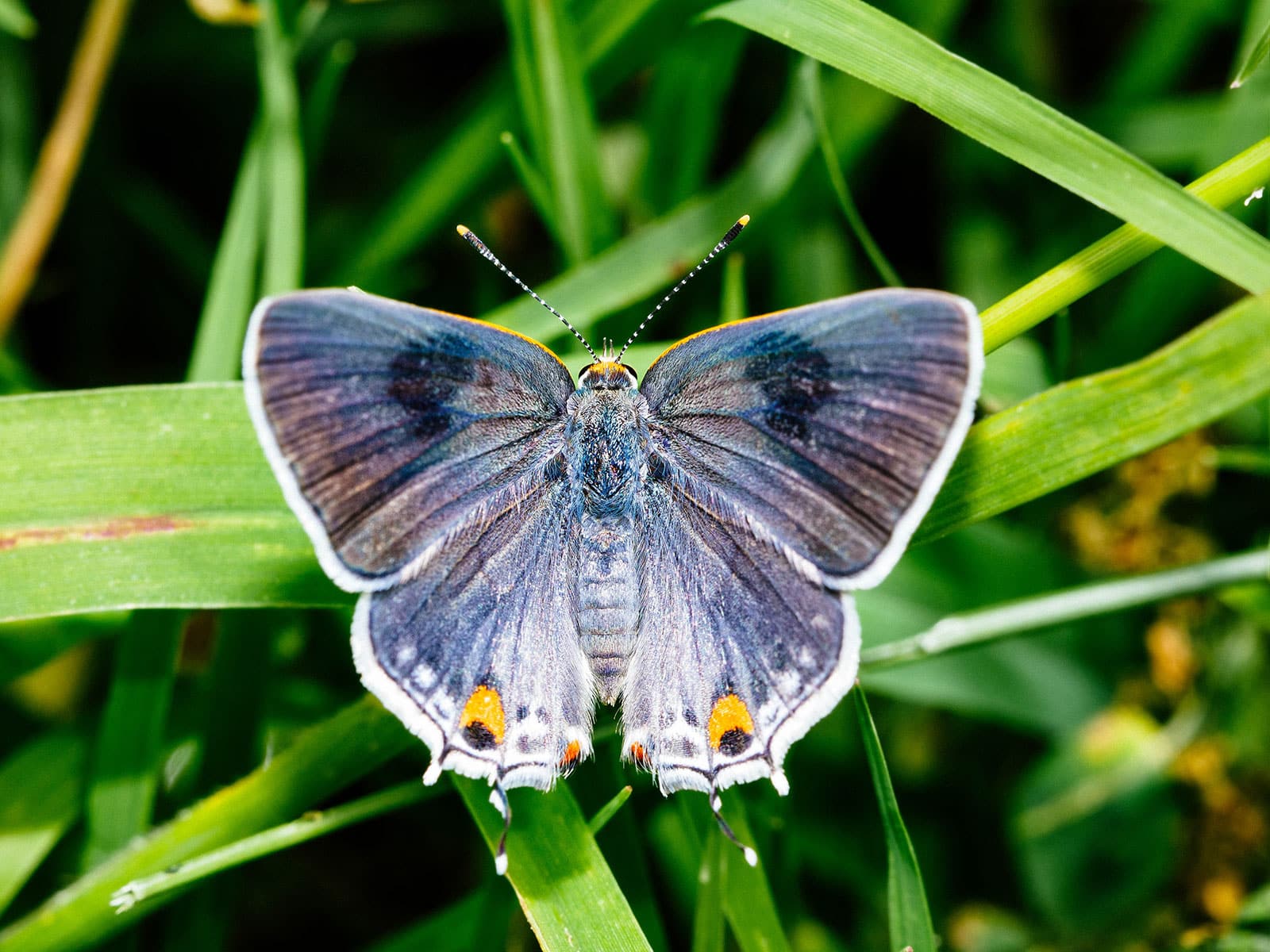
Is it a swallowtail? Nope! Although it has tiny “tails” on its wings, the gray hairstreak belongs to a completely different family of butterflies. Its size gives it away: at a maximum wingspan of no more than 1 1/4 inches, it’s smaller than even the tiniest swallowtail.
The gray hairstreak is a striking butterfly to look at, with white-rimmed, powder blue to gray wings that feature orange spots on the lower parts. It’s very unfussy about habitat, making it common in gardens. As long as there are flowers to extract nectar from, preferably tubular in shape (the same kinds of flowers that attract hummingbirds), gray hairstreaks will come.
Caterpillar: Compact and slightly fuzzy. It’s notably segmented and can range in color from green to pinkish. Not very specific about food, although it does love clovers, mallows, and various species in the pea family.
Did you know?
Like most other species in the family Lycaenidae, the gray hairstreak holds a special relationship with ants. Their caterpillars excrete sweet honeydew, and since ants have a real sweet tooth, they protect them aggressively. Sometimes they even carry the caterpillars around if they think a particular spot isn’t safe enough!
How to attract butterflies to your garden
If it seems like the butterfly population in your yard is a bit low, there are several ways to get more of these winged beauties over for a visit. I cover this in more detail in my guide to creating a butterfly garden, but the basic thing is to offer them food that’s easily accessible.
It doesn’t matter whether you’ve got large acreage or a tiny balcony: planting a few weeds and nectar-rich flowers that native butterflies like is a great start. Try milkweed, or if you don’t mind a non-native plant, a butterfly bush (Buddleia). I’ve noticed the ladies (genus Vanessa) particularly like the latter.
Don’t forget the caterpillars either. To allow butterflies to complete their entire life cycle in your yard, you can plant favorites like milkweed. Herbs like dill and fennel are also popular among caterpillars.
Aside from keeping food sources around, there are lots of little things you can do. Make sure there are sunny spots available for them to perch, clean water in a shallow dish, and maybe some fruit feeders. Avoid using pesticides and, most importantly, don’t keep your garden too neat!
Sources:
Bitzer, R. J., & Shaw, K. C. (1995). Territorial behavior of the red admiral, Vanessa atalanta (Lepidoptera: Nymphalidae) I. The role of climatic factors and early interaction frequency on territorial start time. Journal of Insect Behavior, 8, 47-66.
Dwyer, H. E., Jasieniuk, M., Okada, M., & Shapiro, A. M. (2015). Molecular evidence for hybridization in Colias (Lepidoptera: Pieridae): are Colias hybrids really hybrids?. Ecology and Evolution, 5(14), 2865-2877.
Marshall, L. (1982). Male courtship persistence in Colias philodice and C. eurytheme (Lepidoptera: Pieridae). Journal of the Kansas Entomological Society, 729-736.
Ritland, D. B., & Brower, L. P. (1991). The viceroy butterfly is not a Batesian mimic. Nature, 350(6318), 497-498.
Tabashnik, B. E. (1983). Host range evolution: the shift from native legume hosts to alfalfa by the butterfly, Colias philodice eriphyle. Evolution, 150-162.


